8th Annual Trail Run!!!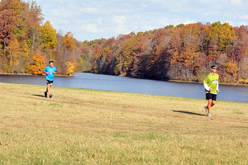 I’ve shared so many of my adventures at Fyrne Lake within the pages of this magazine. You’ve fought alongside me as I’ve battled Kudzu and erosion, encouraged me as I’ve enhanced the habitat for land and aquatic creatures, and laughed with me as I’ve learned the hard way that the skills I acquired in the city don’t always apply out here. I love this country life! This place has truly become our family farm and I hope to keep it in the family (only 86 more years and we’ll qualify as a Century Farm). I count every day I spend at this place as a blessing to be embraced and shared. I’ve shared many of these blessings with you in my stories. Often, I like to share the farm in a different way, by opening it up to the community for a good cause. Mission Blitz is one of those causes. It’s a day of ministry in our community where over 25 churches from multiple denominations come together to be His hands and feet through building wheelchair ramps for the disabled, cleaning and repairing the homes of the needy, reaching out to the sick and lonely, and performing countless other service projects for individuals and non-profits. To support Mission Blitz ( www.missionblitz.org ) we host the Fyrne Lake trail run, nature walk and kid’s obstacle course. It’s a chance to enjoy the natural beauty of God’s creation at Fyrne Lake and help provide the funds for this cause through your event participation fee. Interested in checking out the farm and helping us support Mission Blitz? Your opportunity will soon be here. This event takes place on Saturday, November 10th, 2018 and has something for everyone! 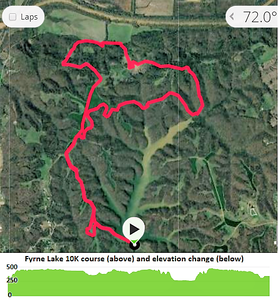 Your kids and/or grandkids will love the challenge of the kid’s obstacle course. It winds its way along the terraces above Fyrne Lake’s pavilion and over what every child loves… INFLATABLES! If you’re too old to qualify (only 11 or under are allowed to participate), you’re sure to enjoy the nature walk. It starts at the top of the terraces and takes you along beautiful tree lines fields, down a forested ridge, through bottomland woods and all the way back to where you started. Interested in running? The same nature trail will be run as a 5K. If you’re up to a greater challenge, you’ll love the adventure of the 10K trail run! This course starts below the pavilion on the dam of Fyrne Lake and takes you by many of my favorite places on the farm. It stretches north through the woods, along farm fields and to the very edge of the Chickasaw bluff, the sight of an amazing lookout which sits 250 feet above the floodplain of the Mississippi. There you’ll catch your breath and enjoy my favorite view on the farm! Miles of farmland can be seen as the flood plain stretches out below and the very bluff that we’re on is visible winding its way north past Bogota, toward Ridgely and eventually Reelfoot Lake. On a clear day the horizon even reveals the state of Kentucky! Once you’re ready to move on, you’ll start your descent, traveling more than two hundred feet down the side of the bluff and pass by a rare gem for this part of Tennessee, a spring fed waterfall! Before discovering it, I had never heard of a waterfall in west Tennessee! In fact, I checked on the internet and I could not find a single reference to a waterfall existing in Tennessee this side of the Tennessee River! There may be others, but even if there are, what makes this waterfall especially unique is its water source. Exploring the woods above the falls, I discovered over 20 oozing springs supplying water so saturated with minerals that a stone coating is left on everything it touches! The waterfall itself cascades over rock that it placed there and continues to so quickly that tree leaves falling into its flow become encased in stone before they have a chance to rot! (Can you tell I’m taken by these falls! I better get back to describing the course!) 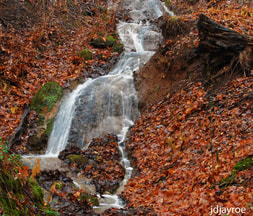 After passing the falls the real challenge begins… the ascent up the bluff! A scenic farm road we created from an old 4-wheeler trail leads you up wooded slopes, beside small ridge fields and through dramatic dips that emphasize what goes down, must come up… assuming you want to make it to the finish line! Eventually, you’ll be rewarded as you emerge in our orchard and follow a mostly level return path that holds one last gift, a panoramic view of Fyrne Lake itself as you approach the finish line! Would you like to participate? Registration is now open for the challenge of the 10K and 5K trail runs, the beauty of the 5K nature walk and the fun of the kid’s obstacle course at www.fyrnelake.com . Our presenting sponsor, Hilliard Lyons, and numerous supporting sponsors from the community (see www.missionblitz.org for a list) join us in inviting you to this family event to support Mission Blitz. In addition to all the excitement of the activities, you can sit back and enjoy free food, great live music and share the natural beauty of our very own, Fyrne Lake Farms. The farm is located 10 minutes northwest of Dyersburg, TN on Highway 182 (6875 Lenox-Nauvoo Road). The timed 10K run will award first, second, and third place metals for male & female runners in multiple age brackets. The non-timed 5K run will provide participation metal to each finisher and the kid’s obstacle course participants will receive a souvenir wrist band allowing them to repeat the course as often as time allows. Want to find out more? You can visit www.fyrnelake.com, email [email protected] or call 731-676-5556. Also, ALL area churches are invited to be a part of Mission Blitz. So, if your church isn’t already participating, forward their contact info to me at [email protected] and I’ll formally invite them to join us in being the hands and feet of Christ in Northwest Tennessee! 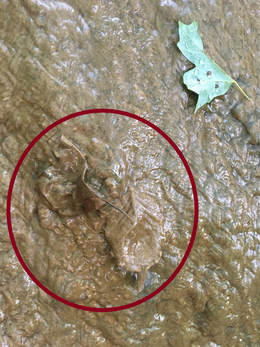 This close-up of our waterfall’s stone shows how its mineral water quickly encases fallen leaves (see inside circle) before they have a change to rot! 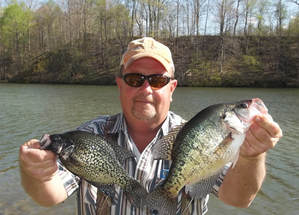 Fish, especially predatory game fish like crappie and bass, love to hide in, around, and under structure. Most of us fisherman know this fact. The challenge is finding fish structure in the right place and at the right depth for the time of year and day we’re out fishing. Figuring all this out is part of the fun and challenge of our chosen sport. Many of the more experienced fisherman have found it useful to map the structures they’ve identified over the years at their favorite fishing holes. And believe me, it works! Every wonder why the old timers on a lake seem to be doing better than you? That doesn’t mean they’re necessarily better fishermen. They just know where the fish are hiding! Pictured above: Jeff Caldwell- The truth is found in the catch! Above are two of the many crappie Jeff’s been catching off the structure he created, transported, and sunk in Fyrne Lake. Pictured Below: Brush Pile Map-A lake map can help you quickly get up to speed on early visits to new water. This particular map is of Fyrne Lake displaying its shoreline shape, depths and the placement of fish attracting structure. Want to increase your chances for a good day of fishing on a new body of water? Get the inside scoop from someone who knows the water. No luck? Stop at the closest bait shop, buy something (this softens them up to your question) and ask for help. They might even have a fishing map! If available, a fishing map saves a huge amount of time getting up to speed on a body of water by giving you an overhead view of its shape, various depths and, if you’re lucky, the location of underwater brush piles and other natural or manmade fish attracting structures. A good example of a fishing map accompanies this article. It’s of Fyrne Lake which is on my family’s farm near Dyersburg. On it you’ll see an outline of the shore, graduated water depths and various structure locations. It has helped many a fisherman get to know the lake in record time! 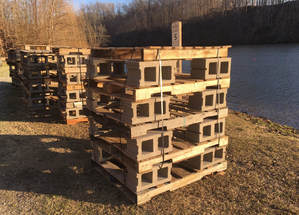 Four pallet stacks are shown assembled and ready to be placed in Fyrne Lake. Note the large hiding place gaps between each pallet created by the cinder blocks used to weigh down each structure. Four pallet stacks are shown assembled and ready to be placed in Fyrne Lake. Note the large hiding place gaps between each pallet created by the cinder blocks used to weigh down each structure. Structure is so important to the health of any lake’s ecosystem as well as to the luck of any knowledgeable fishermen. Fyrne Lake virtually had no structure when we purchased it in 2004. Realizing its many needs, we immediately started working on improving the lake through removing unwanted fish, stocking desirable fish (various baitfish varieties and breeder size crappie) and adding structure. Over the years we’ve added a huge variety of materials for fish habitat starting with cutting trees to fall into the lake along its shoreline. Even though we only cut those likely to eventually fall on their own, I still mourned the loss of every tree. I just had to find another way! The lake needed massive amount of structure. What could we use?... I had an idea! Christmas was approaching and there would be hundreds of used trees that would eventually go to waste in the city’s landfill or a nearby gully. Why not recycle them into Fyrne Lake? So I contacted the city and obtained permission to set up a collection point in town. New Year’s came and the trees started piling up! The first year we recycled over 200 trees into the lake and in the years since we’ve added hundreds more! There was only one drawback. Once submerged, Christmas trees only last 3-5 years. The lake needed additional structure that would have staying power. After more research, I tracked down a gentleman from Paducah, KY by the name of Larry Harper. He was the inventor of a PVC based fish structure that he called at the time the “Oh-No Hang Fish Attractor”. Later he partnered with Bill Dance and changed the name to the “Porcupine Fish Attractor”. No matter what you called it, it worked! Over the years we’ve assembled hundreds of Mr. Harper’s fish attractors in different configurations and sunk them near downed trees, by brush piles, and off points. They’ve made a difference. But, we still needed much more structure in the lake to come close to what the lake, the fish, and the fisherman really needed. Scanning the internet for ideas, I ran across a state fishery department using stacks of pallets for fish structure. Such a cool idea! Pallets are inexpensive (or even free) and I could imagine multiple ways to combine pallets creating long lasting structure sporting various sized cavities rising many feet from the lake’s bottom. It wasn’t long before there were huge freshwater reefs with multiple pallet stacks surrounded by their own forest of sunken upright Christmas trees (check out the depth finder image). This detailed depth finder image reveals a freshwater reef created by pallet stacks and vertically placed Christmas trees. Playing with the pallets started my creative juices flowing! I began combining PVC pipe and corrugated drain line into large brush pile like creations. I also identified a low cost (or free) natural structure source, landscaping debris! I obtained removed hedge plants, small trees and larger trimmed branches from local landscapers to create multiple brush piles. The possibilities for structure are endless! And the cool thing is the immediate payoff. Fish are often caught off these new structures within days! Plus, the out-year dividends are immense by measurably increasing the number of fish the lake can support. I was making progress, but I wasn’t doing it all by myself. Early on several fishermen on the lake offered their advice. One in particular, Jeff Caldwell, had been watching me struggle with managing the lake from the beginning. He had often expressed to me how much the lake desperately needed more structure. Jeff was a crappie fisherman by choice, and a good one. There was nothing he enjoyed better than bringing home a mess of fresh caught crappie for supper! The sad truth was that despite its potential, Fyrne Lake wasn’t providing the quality crappie fishing he was after. Most people would have given up and moved on. Not Jeff! He believed in the lake and my vision for it. And he was willing and able to help! Jeff Caldwell Condos: Here’s a porcupine fish attractor that was customized by Jeff Caldwell with two pieces of corrugated pipe providing more places for fish to hide 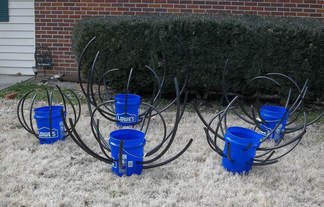 Plastic Stumps: Jeff Caldwell’s stump creations are shown assembled and ready to sink in Fyrne Lake. Plastic Stumps: Jeff Caldwell’s stump creations are shown assembled and ready to sink in Fyrne Lake. At first, Jeff started using the traditional starburst shaped porcupine fish attractors. Relying on his years of experience, he placed the PVC structures in coves and off points. It wasn’t long before Jeff began catching fish. Other fishermen noticed his success and realized the advantage of creating their own structure. Controlling where and how deep material is placed and WHO knows where it’s sunk is a fishing advantage! Sure, others would eventually find the structure on their own or when they notice you catching fish near it. But, you would still be the only one who knows the details of what was sunk and that is a HUGE advantage in knowing how best to fish it! Jeff understood this secret and started experimenting in customizing his structures. Jeff added short sections of large diameter corrugated pipe to the starbursts creating dark recesses as fish hiding places. That helped, but he couldn’t get out of his mind how productive stump areas are for crappie at Reelfoot Lake. Why couldn’t he create his own! With the help of a few trusted friends, he rounded up 5-gallon buckets, filled them with concrete and added branch like appendages made out of varying lengths of black pipe. Not only did they look like stumps to the fish… they attracted fish! The ideas kept coming. Soon he began adding to their buckets a tall vertical PVC pipe with smaller perpendicular pipes attached to simulate branches. The creation appeared like a tree growing out of the bottom and stretching up toward the water’s surface for as many feet as he chose to build. His most recent project involves vertically mounting multiple lengths of black pipe on pallets creating long lasting crappie stake beds. Here’s one of the taller PVC trees in the back of Jeff Caldwell’s boat, ready to sink. The reality is that fish love structure, almost any kind of structure… IF it’s placed where they want to be! Depending on the time of year, water temperature, and weather conditions of the day, fish will prefer different depths. The surrounding underwater topography also effects each structure’s attractiveness. Being near a point or drop off is a big plus! Placing structure at the end of a fallen tree that stretches out toward deep water attracts fish like a magnet. Creating a line of structure spanning multiple depths will often hold fish year-round by allowing them to stay protected and adjust their depth as the seasons and water temperatures dictate. Anyone can create fish structure in water on their own land. With private lakes like Fyrne Lake and in public waters just ask permission and proceed as allowed. Jeff and his friends have done it and you can too! Feel free to copy any of our ideas or make up some of your own! Your only limit is your imagination and the capacity of your freezer!
 Do you remember walking on red gravel roads as a kid? If you grew up in our area of west Tennessee, I bet you did! These roads were everywhere and, if you paid attention to the gravel, you’d likely find a Lucky Stone. If you never found one, you missed out! Kids would keep these treasures in their pockets for good luck, like a rabbit’s foot. (Do you remember those?) Why were they lucky? I think they were labeled as lucky because it took a little effort to find one and these stones were just plain cool! Looking nothing like the smooth gravel surrounding it, the Lucky Stone’s cylindrical shape would stand out. Adding in their ribbed (1/8” - 1 ½” or more) length, you would have found something very unique and worth sticking in your pocket to examine more later. Native Americans thought these stones were very cool as well! They saw them as precious enough to use in jewelry (ever heard of Indian beads?). Obviously, their source wasn’t red gravel roads but our area steam beds. Lucky Stones weren’t the only material used by the Indians as beads. But they were often used by tribes where Lucky Stones were found. What are Lucky Stones? Believe it or not, they are a fossilized body part (the stem) of a sea creature called a Crinoid that lived in our area of the country when it was covered by a shallow sea. This ocean’s bottom was covered by these creatures… billions of them! They were joined by various species of sponges and corals, many of which have also left evidence of their life in the gravel. Crinoids were beautiful! They came in many shapes and sizes. Most variations shared common traits that included an attached base, long central stem and feather like extensions on their top making each look very much like a small palm tree, but it wasn’t a plant at all. It was an animal that lived life like a coral, stationary and nourishing itself through filtering much smaller (often microscopic) animals and plants from the water (see picture with this article). Interesting isn’t it? I love hunting fossils even more than I do rock hounding (see my last article on geodes in July/August 2017 Southern Traditions Outdoor Magazine or on my blog at www.fyrnelake.com). Every fossil represents a picture of life in the past. Holding one transports me on an imaginary journey of what it would have been like to see it face to face. Imagine finding yourself in the water with a 50-foot Megalodon shark or huddling behind a tree in an ancient forest listening to the breath of a hungry T-Rex just 10 feet away! I’ve hunted fossils all my life. Growing up in Florida, I was surrounded by fossils. I’ve found ice age mammal bones in the rivers, shark teeth on the beach, and even a whale bone during the excavation of a retention pond being dug behind my business. It’s like a treasure hunt, history lesson, and detective mystery novel all wound into one! When I started spending more time in Tennessee I wanted to continue my hobby. It wasn’t long before I discovered fossils below my feet, literally! That’s when I picked up my first Lucky Stone on the farm. I recognized it immediately as a Crinoid stem section similar to the ones I found in streambeds on my grandmother Fyrne’s farm in Indiana. I discovered the same shallow sea that covered parts of Tennessee also extended over much of the Midwest including where my grandmother’s farm was in southern Indiana. Traces of this fossil bearing red gravel can be found throughout these states where the varying shoreline of this ancient ocean tumbled the gravel smooth along its beaches. Like seashells, the Crinoid stems mixed with the gravel and were eventually buried to be uncovered many years later by erosion or, in the case of red gravel roads, excavated from pits. The red gravel used for our road was from a pit near Troy, TN. Could there be a similar gravel deposit on my own farm? Sure enough! Halfway down the slope of the Chickasaw bluff (where my farm is located) are outcroppings of this red gravel. In fact, each of the three land parcels that make up that section of my farm had a history of being mined for gravel. I discovered three old pits and one had even been used for county roads as recently as the 80s. “This is cool!”, I said out loud to myself. It didn’t take long before I started finding my own Fyrne Lake crinoid stems. The reality is that it’s easier to find fossils in gravel when it’s spread out for a road or parking lot. My older son, Jeremy, and his girlfriend Sarah especially enjoyed hunting the pavilion parking lot near the lake on our farm. I was amazed at the variety of fossils they discovered… literally pounds of crinoids, corals and sponges! Jeremy even discovered a fossil impression of a Trilobite! Trilobites were a very cool family of extinct arthropods that was made up of 1000s of species ranging from 1/10 to 30 inches in length most looking very much like a segmented horseshoe crab (see picture of fossilized trilobite). The fossil impression he found was like a footprint in the rock that revealed the creature’s unmistakable shape. A three dimensional fossil like the one shown in the picture would have been more cool. However, to find ANY trilobite fossil in red gravel is rare making this find a real treasure! My son Jeremy is as hooked on hunting fossils as I am. During his childhood we hunted them together in phosphate pits, along road cuts, in rivers, and on beaches. He even crawled around with me at the pond construction site behind my Florida business where we found the whale bone. He’s now almost 30 and we still hunt together, concentrating most of our energies on the holy grail of fossils… DINOSAUR bones! However, the red gravel on the farm still draws Jeremy’s attention whenever he visits. Are you ready to start hunting your own fossils? Maybe even start a Lucky Stone collection? Just in case you find your eyes wandering down toward the red gravel below your feet, check out the pictures of what we’ve found in the gravel at Fyrne Lake. Happy hunting and may the Lucky Stone be with you! 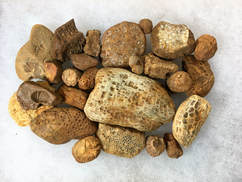 There’s more than just Crinoid fossils in the gravel! Here are a few examples of the many sponges, corals and shells fossils we’ve found on the farm. 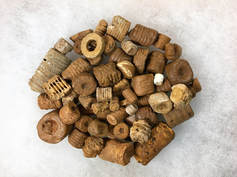 We found these lucky stones in the red gravel from the roads on our family farm. Each one is actually a fossilized stem section of an ancient sea creature called a Crinoid. 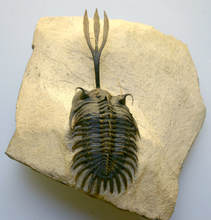 This fossilized Trilobite is one example of a cool family of extinct arthropods made up of 1000s of species ranging from 1/10 to 30 inches in length. Picture by Kevin Walsh – Wikipedia/Flickr / Link: https://commons.wikimedia.org/wiki/File:Trilobite_Walliserops_trifurcatus.jpg 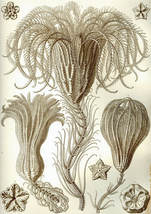 Crinoids were beautiful sea creatures that came in a variety of shapes and sizes. Fossilized sections of their stems can be found in our local red gravel roads and stream beds. Drawing by Ernst Haeckel - Wikipedia / Link: https://commons.wikimedia.org/wiki/File:Haeckel_Crinoidea.jpg 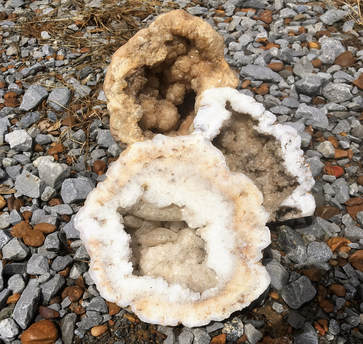 Like a chocolate, you never know what you’ll find within a geode. Depending upon the multiple variables involved in its creation (minerals present, temperature, acidity, length of time, etc.) you could find huge beautiful crystals or a solid rock. Discovering what’s inside is just part of fun of rock hounding. Like a chocolate, you never know what you’ll find within a geode. Depending upon the multiple variables involved in its creation (minerals present, temperature, acidity, length of time, etc.) you could find huge beautiful crystals or a solid rock. Discovering what’s inside is just part of fun of rock hounding. Do you know what a rock hound is? It’s not a hunting dog or a stone figure. It’s someone who loves to search for rocks and fossils. If you’ve met me you’ve met one! Besides being obsessed with my farm, I’m obsessed with rocks. Anyone who drives up to my barn immediately sees the large pile of Indiana geodes. I can’t help myself! Since my parents have been spending part of the spring & fall on our Tennessee farm, we take the opportunity to frequently make a pilgrimage to southern Indiana where we decorate my grandparent’s graves, visit areas that hold family stories and search for rocks. Near Mitchell, Indiana where my maternal grandparents are buried, is an area the locals call the Devil’s Backbone. It’s known for dramatic hills and geode rocks. What’s a geode you ask? Geodes come in many types and sizes. Depending upon the area of the world they were formed, they can be quite beautiful, even breathtaking. All geodes share two common characteristics, a cavity located within a rock and an accumulation of minerals, often in crystalline form. Indiana geodes are externally distinctive making them easy to recognize. They look like a head of cauliflower made of stone. What makes them cool is that many, not all, are hollow with varying sizes & qualities of calcite crystals. Occasionally you’ll find one with a smooth bubble like interior. Any of them are interesting to me. I even enjoy their unique exterior. Apparently, the locals like it as well. Many residents northeast of Mitchell use geodes for yard decorations, flowerbed borders and even geode fences. In fact, when I start seeing geodes in yards, I know it’s time to start looking. Entering this area from the south you drive through a small town called Tunnelton. You actually go through a very narrow one lane tunnel under a railroad track (apparently the source of their name). As soon as you exit the tunnel geodes are visible in a small creek to the right and displayed in the yards of the residents as you continue through the community. This tunnel marks the beginning of geode country. Now the fun begins! The challenge is to find these amazing stones without trespassing on private property. My strategy is to look for cuts along road right of ways and creeks crossing underneath. As you drive further into the hills to the north and northeast, the opportunities will present themselves. We always return with multiple 5 gallon buckets full. I’ve got so many now I’m becoming a little (I say a little) more discriminating on what I’ll bring home. I now concentrate my efforts on finding larger and more hollow geodes. How can I tell if they’re more hollow? By how their weight compares to others the same size. Eventually, you get a sense of how light a stone needs to feel in relation to their size to gauge how hollow they are. When visiting southern Indiana, we always try to stay in the lodge at Spring Mill Park. It’s a beautiful CCC depression era constructed building that transports you back to a simpler time. The rooms are furnished with Hickory branch framed furnishings adding to the rustic ambiance. The lodge is located deep within the park, which itself is worth exploring. The mature hardwood forest has miles of trails, there is a large 19th century period village with a functioning water powered grist mill (you can even purchase its cornmeal), and a cool cave with boat tours. The park can definitely be a destination in itself. However, we just use it as a home base while visiting. The park is about 5 ½ hours from Dyersburg. When traveling there, we normally start out in the early afternoon with the goal of arriving before dark. If we’re early enough we can catch supper in the lodge dining room. The food is great but the real treat is having persimmon pudding for desert! It’s a mainstay in southern Indiana. I grew up on it and it’s still one of my favorites. We even make it from the persimmons on our Tennessee farm. (For more details on persimmon pudding and a recipe see my article in the xxxx/xxxx 19XX issue of this magazine or visit my blog @ www.fyrnelake.com.) If it’s still light after supper, we’ll take a hike on one of the trails burning up any energy we have left. The next morning we head out to a nearby cemetery to decorate the grave of our farm’s namesake, Fyrne Taylor, my maternal grandmother and my grandfather Frank Taylor, who was a real cowboy that cared for the riding horses at the Spring Mill Park when he wasn’t farming. Decorating the graves is a tradition in southern Indiana. Normally silk flowers are used which last until the next visit. We remove the old and carefully replace them with new all the while recalling pleasant memories of our lost loved ones. After decorating the graves we head northeast toward the Devil’s Backbone. The locals gave the area that name because of the long, curving and steep ridge that cuts through the area, very much like a serpent’s backbone. There are multiple unmarked intersecting roads that make navigation difficult, especially if you’re trying to find a good spot you’ve hunted before. Yes, GPS would help. And we occasionally will turn it on. But I prefer to wander the hills looking for cuts along and under the roads in the hopes of finding a geode it will take two of us to lift! Large geodes are rare. 8” diameter or smaller are common and easy to find in this area. My grandparents had found several 12” and larger specimens during their lifetimes. However, I had only dreamed about finding one myself until last year’s visit. My brother Kris, who works at Fyrne Lake with me, came along on this trip. While driving through the hills we noticed a small cut, almost too small to be called a creek, crossing under the road. I’ve driven past this area multiple times without noticing the creek because of its size and the surrounding thick brush cover. We stopped the van, and with my father and mother staying in the vehicle, Kris and I started exploring. As soon as we pushed our way through the brush and down into the cut, geodes were visible everywhere! We immediately started filling our buckets, each one weighting 75 lbs+ and struggled to get them up the bank and back to the van. We had filled 4 within 50’ of the car. But, there was so much more to explore! It seemed like this area had never been hunted. There was a higher percentage of larger (8” and over) geodes than I had ever encountered before. Maybe, just maybe, there’s a 12” plus just around the next bend, I hoped. My excitement grew as Kris and I continued down the creek. We became more discriminating in what we gathered realizing the accumulating weight and the expanding distance up and back to our vehicle. Kris focused on the stream bed as I began searching the banks. The geodes are randomly found at and below the surface of the soil throughout this area. The only reason we concentrate our search along creeks and road cuts is these washes expose and accumulate the stones from the soil through multiple years of erosion. I’ve often found geodes partially exposed along the banks. This time was no different. I worked my way up surveying the ground. As I approached the base of a larger tree I came across an eight inch diameter exposure of cauliflower like rock. This could be a pretty good sized geode, I thought. It’s worth digging out. I grabbed a stone and started clawing out the dirt around its perimeter. It kept going! I was getting excited! “Kris!” I yelled. He was there in an instant, grabbed a rock and started digging with me. Ten minutes later we rolled it out. WOW! This rock was HUGE! This was definitely the largest geode I had ever found. It was even larger than any of my grandparents’ stones. I tried to lift it and stopped. There was no way I was going to get it off the ground. Kris and I stared at it for a moment pondering the steep bank above and the 50 yard horizontal journey before us. Kris had an idea, “What if we rolled it?” That just might work, because most geodes, like this one, are round. The two of us positioned ourselves downhill from the rock and started pushing. Slowly, we made progress up the hill around trees and through poison ivy. Eventually we crested to level ground. Now we could take turns pushing this treasure along. Our next challenge awaited us at the van. How were we going to get it in? Luckily, we had a stout box, wrestled it in and together heaved it up into the back. Our find was secure! How big is it? We’ll it was big compared to anything else I had ever found. It measured over 43 inches around close to 14 inches in diameter. Now, I was really excited and the day was still young! We got back in the van and drove on down the road. It wasn’t long before we came across an ancient steel bridge spanning a small river basin. We immediately pulled over and grabbed our buckets. It seemed like only seconds before we found ourselves walking through the mother lode! The river level was extremely low with much of the bottom exposed. And what an amazing exposure it was! As far as we could see there were rocks, and not just any rocks… GEODES! Some were even split open exposing their beautiful crystals! Kris and I were giddy with excitement. Our challenge now was to decide which ones to take. Our van could only haul so many pounds. Boy, I wished we had our farm truck, better yet our dump truck! But alas, we had to limit our take to a few hundred pounds or maybe 500 or possibly even more... whatever I thought I could get away with without threatening the van’s suspension. I planned to find out just what it could handle. As we filled our buckets we began finding other unique rocks. These weren’t geodes, they were fossils! (I love fossils too!) They were of ancient sea life including sponges, corals and crinoids. I was in heaven! (more on fossils in another article.) We spent the next couple hours filling, dragging and loading buckets until the van cried uncle! It was visibly squatting on its tail end. So, I moved what buckets I could toward the front until the squat wasn’t quite as pronounced. “Now” I said, “Let’s see if we can make it back to the inn.” Luckily, we not only made it back to the inn, but the next day we made it to my paternal grandparent’s gravesite, drove by our family’s Indiana farm and made it all the way back to Dyersburg. I won’t lie, the van rode heavy, was slow to stop and the shocks bottomed out on several bumps along the way. But, it was worth it! I now have my huge cauliflower rock to admire, a handful of precious fossils to add to my collection and a substantially larger pile of geodes. I’ve now given my wife another reason to think I’m crazy. (As if she had any doubt!) I may have even given you one! Does being a rock hound intrigue you? If so, you don’t have to go all the way to Indiana to find interesting rocks and fossils. In future issues I’ll share with you a few of my experiences rock hounding closer to home. 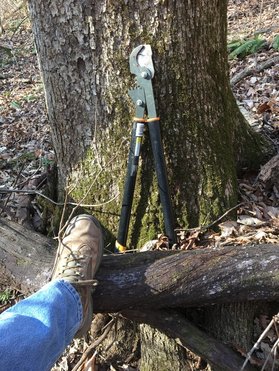 This 8” diameter vine under my foot must have been 50 years old! It was much to larger for my lopers to get around. However, my curved pruning saw cut it in no time. This 8” diameter vine under my foot must have been 50 years old! It was much to larger for my lopers to get around. However, my curved pruning saw cut it in no time. I’m in the middle of a war! A war to save my farm from the mistakes made in the past. My approach may be a little obsessive. But, I’m not afraid to admit it. I am obsessed with protecting my farm! Like many of the people I’ve meet that have family land, I want to care for it, protect it and encourage its natural environment for the enjoyment of my family, their kids, and later generations. One of the major battles in this war is with vines, kudzu being the most intense. But, this article isn’t about kudzu (you can read about my battle with this invader from Japan in the June/July 2012 issue of this magazine, also posted on my blog @ www.fyrnelake.com). Today, I want to describe another threat to our woods that is just as destructive, visually destroying the beauty of field tree lines and fence rows while slowly starving to death trees in our forests. This threat is posed by native vines that are a natural component of our local ecosystems. Normally they would pose no threat to our forest. However select cut timber harvesting and field clearing have upset the delicate balance between trees and vines, surrendering the protection of its canopy and allowing light to penetrate to the forest floor across vast areas. This additional light gives vines the advantage encouraging them to quickly ascend trees and spread out over their upper branches blocking out sunlight and slowly starving the trees to death. I shared with you in my last article (also on my blog @ www.fyrnelake.com) that I was first exposed to this threat on my original farm hike. I discovered vines intermittently covering the forest’s perimeter tree lines and, under its canopy ascending trunks and slowly killing trees. I was worried and knew something had to be done! I immediately added this battle to my growing list to protect and care for my farm. The sheer scale of the problem was intimidating! There were acres of woods and miles of tree lines. I never would have begun if I had let the size of the problem overwhelm me. I started out trying to save one tree, then another and another, taking satisfaction with each success. Over the years I’ve saved thousands of trees and I’m still working at it. In fact, fighting vines (including kudzu) has become my exercise regiment, working my upper body with loppers, clippers and a hand saw while working my lower body hiking the wooded hills of the farm. Maybe you can benefit from my efforts. Do you or your family have a farm or hunting land? Do you care about the trees surviving for your kids and their kids? Or maybe you just want to preserve the trees for harvest. No matter the reason, I’ve developed several effective strategies to win this battle against vines. I’ve also identified several very cool hand tools (weapons) that make battling vines an easier task. I would even say fun! With these tools, I can clear acres of land in a day with the confidence that I’ve tipped the scales back to the trees’ advantage. Strategies: #1) Do not cut poison ivy or poison oak vines! Poison ivy vines rarely extend their reach above the tree canopy blocking out sunlight. So cosmetic appearance would be the only reason to cut their vines. However, your own cosmetic appearance could be drastically affected when their oil sprays out on you and your clothes when cut. Getting poison ivy takes all the fun out of being in the woods! I recommend staying clear and concentrate your effort on the vines that truly damage trees. I learned my lesson the hard way. Want to know more about my experiences with poison ivy? See my article in March/April 2017 issue of this magazine or visit my blog at www.fyrnelake.com. #2) Take personal safety seriously! Dead leaning trees and broken branches are like booby traps suspended overhead that will often shift or fall when cutting vines. Don’t tell my wife, but, I’ve had more than one branch crash down beside me while I was working on a vine. I’ve now learned to ALWAYS look above and around before attacking one. When cutting in warmer weather, snakes can and will be present. I’ve been lucky. The snakes I’ve run into have always announced their presence before I’ve gotten close. However, in the summer I ALWAYS wear snake boots and keep a wary eye out for ANY movement on the ground. Not every venomous snake has rattles! Like me, you may prefer to do the majority of your vine cutting during the cooler months. Besides being snake and bug free, the absence of leaves makes spotting and cutting vines much easier. I also prefer being a little cold than drenched in sweat and attacked by chiggers and ticks. Speaking of insects, when I’m cutting in the summer I NEVER go into the woods without a light long-sleeve shirt, wide brim hat, gloves and insect spray to keep the bugs out of my hair and off my skin. Is this sounding like fun yet? #3) Use the best hand tools! I’ve tried and destroyed a lot of tools in my vine fighting efforts and have settled on four specific weapons that have seriously impressed me. The majority of the vines under the tree canopy are ½ to 2 inches in diameter, the perfect size for a good quality lopper… at least I thought! However, most of the vines I ran into were dense and a struggle to cut with standard loppers. I went through quite a few brands and models before I discovered the Fiskar 32” PowerGear lopper. It has a 3-to-1 gear ratio that multiplies your efforts and makes quick work of any vine you can fit within its blades. Something about its patented design makes it superior to any other lopper I tried, even other gear multiplying models. In fact, they’re designed so well that I’ve often successfully cut a vine way beyond its rated diameter capacity by getting a partial bite on the vine and working my way around until I’ve cut completely through! However, some vines are just too large and require heavier artillery. That’s when I bring out my curved pruning saw. I recommend the[KG1] Corona 18” razor tooth pruning saw. It’s compact, light-weight and the perfect size to cut through a large 4-8” vine in one to two minutes. Obviously a chainsaw would be quicker. But, since most of the vines I encounter can be handled by my loppers I prefer not to lug around a heavy chainsaw. Even carrying my hand saw with the loppers gets old. More than once I’ve set down my saw to cut vines from the surround trees and have lost track of where it was! After having to replace a couple lost saws, I came across what’s called a pocket chainsaw. I had never heard of it before coming across it at a camping store. It’s basically a chainsaw blade with handles that folds up and fits in a small belt pouch. It doesn’t cut as quickly as my curved pruning saw. But, I was surprised how well it does works and I haven’t lost one yet! Along the tree lines I often run into large areas of tangled small diameter vines. I started using a standard handheld hedge clipper. It cut the mass of small vines much faster than I could with the lopers, but had limited reach and its weight seemed multiplied as I stretched out to cut as many vines as I could from one place. Why did I not just step closer? Two reasons, these masses of vines were normally located along the outer tree lines of the forest which were often lined with briars. I usually had to push my way through several feet of thorny brush before I could reach a single vine. Once positioned, I wanted to cut as much as I could reach to minimize the need to push through the sea of scratching thorns. The other reason involves gullies. My farm in particular is full of gullies and many times these vine masses would stretch out over a gulley just out of reach of my standard clippers. As Tim Taylor would say in the TV show Home Improvement, “I need more POWER!” I sought out and found from a place called Gempler’s, the lightweight ARS HS-K900Z telescopic hedge shear. The handles are aluminum while the blades are stainless. I especially like the telescoping feature that allows me to stand in one place and reach three times as far as before. I was impressed! I now had all the tools I needed! 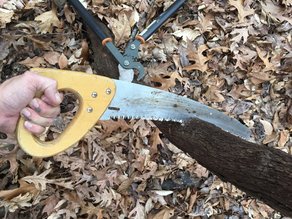 Here’s my 3 to 1 geared lopers getting its teeth around a good sized vine. Once I had it fully surrounded, there was one less vine in my woods. 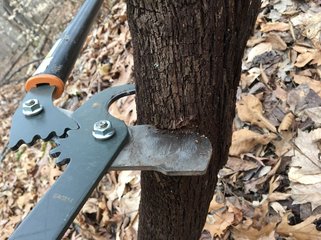 Here’s my 3 to 1 geared lopers getting its teeth around a good sized vine. Once I had it fully surrounded, there was one less vine in my woods. 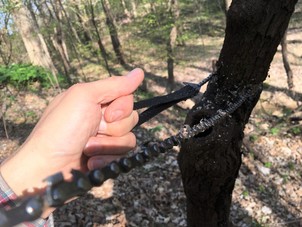 What I love about this hand powered pocket chainsaw is how it fit’s compactly in a small belt pocket. It cuts well too! #4) Spray a glyphosate based herbicide like Round-up. Just cutting the vines where sunlight is abundant along the tree line isn’t enough to get rid of them. I’ve found that it’s necessary to circle back through a few weeks later to spray any sprouting vine stumps. The good news is I’ve discovered that it’s seldom necessary to spray the vines that I’ve cut under the tree canopy… unless it’s kudzu! Kudzu’s roots store such a reserve of energy they can easily climb back up the tree. Native Tennessee vines quickly deplete their energy reserves in the limited light while attempting to climb back above the canopy. For added insurance, I make it more difficult for them by cutting each vine twice, once near the ground and once close to chest level. This gap is usually sufficient to keep the vines from taking the easy way back up the tree on what’s left of their now dead upper member. They’re forced to attempt the only way left, up the larger diameter tree trunk. So, are you ready to have fun yet? Or, do you think I’m crazy? My wife probably thinks so. She’s seen me head out into to the woods countless times to cut vines and returned dead tired, drenched in sweat, covered in dirt and wearing a huge smile. That smile is even wider these days. It’s difficult to describe the deep feeling of accomplishment I experience when hiking through now healthy (and mostly vine free) areas of the farm. I also feel in my bones (literally) that this effort has keep me more fit and feeling young. It’s not too late for you to have the same experience saving your own trees! Don’t have your own? I might even let you cut a few of my vines. (I also have a fence that needs whitewashing.) I’ve already figured out a system that works well for me and it will work for you. All that it will take is respect for poison ivy, awareness of what’s above your head and below your feet, the purchase of a few awesome tools to make the task easier and an abundance of patience. Patience will serve you well as you free one tree at a time. Depending upon the size of your woods, the task of freeing it all may take years. Staying focused on your goal and taking satisfaction with each freed tree will help you keep motivated. I can assure you the results you’ll attain are worth it. You may just become as obsessed as I am! My telescoping clippers helped me clear out this tangled mess of vines in about 10 minutes. Check out the before and after pics. The absence of leaves in the winter reveal how the vines are devastating the forest. It’s hard for me to hike by a scene like this without cutting a few.
This article is referred to in the previous blog post (Vines… 3/9/17) and appeared in the June/July 2012 issue of Southern Traditions Outdoors Magazine. 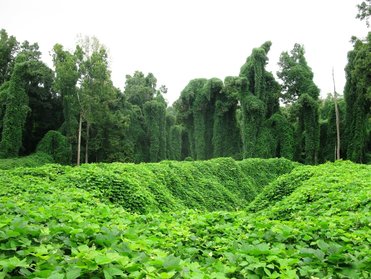 I don’t know about you, but I am fed up with kudzu! I have seen it along highways for years covering everything within its grasp: trees, telephone poles, electric lines, houses and even cars. It seems that anything that stands still will eventually be covered by this vegetative beast. And that isn’t far from the truth! Under ideal conditions kudzu can grow 12 inches in a single day and can scale anything it can hold on to! As so often happens with other invasive animals and plants, kudzu was introduced to the US with good intentions. It was imported from Japan to control erosion along hillsides and gullies. In reality, kudzu only slows one type of erosion, impact. Impact erosion occurs when raindrops fall directly upon bare earth, breaking soil particles loose and making them easier to wash away. The leaves of the kudzu vine do protect the ground from the majority of these impacts. However the second type of erosion, run-off, is simply hidden by the leaves. Run-off erosion happens when water flows over the ground, picking up loose particles of soil along the way. The best type of plant to control run-off erosion is one that locks up these soil particles within and under a dense root and foliage mass. Kudzu vines have a very sparse root system relying mainly upon one central tap type root shaped very much like a long and narrow sweet potato that can extend several feet into the ground. As the vines radiate out they will occasionally send out shallow root type extensions that help the vine adhere to whatever landscape or surface it encounters. When growing along the ground these shallow roots may create another narrow tap type root. The majority of the area under kudzu is root free. This is partially because of kudzu’s limited root system, but also because the kudzu vines eventually kill off every other rooting plant under their leaf canopy leaving the soil vulnerable to run-off erosion. I didn’t become personally acquainted with kudzu until we purchased our farm near Dyersburg, Tennessee. There were several kudzu areas along the road and a few spots isolated deep in the woods. What concerned me about these vines was what they were doing to the trees. All along each area’s perimeter the vines extended up and over the top of trees, smothering/starving them by blocking sunlight from reaching their leaves. As I inspected these areas, I saw standing and fallen dead trees that had been covered and killed years before. Some were large majestic oaks or hickory. I had to do something to stop this destruction! I started investigating ways to kill kudzu. But, most of the locals I spoke to had given up fighting kudzu years before. Some had tried fire (it just grew back), others had sprayed chemicals (enough survived to come back) and others had tried goats. Goats will eat anything, including kudzu. In situations where you can securely pin them in, goats are a solution. That wasn’t possible on our farm or for many farms in our area. Most of the kudzu had been purposely placed in areas of severe erosion surrounded by rugged terrain. There areas could not be practically and securely fenced. Even if we were successful, the erosion the kudzu was hiding needed to be controlled. That would not be possible with goats present. After much research and experimentation, I settled on a plan that is working for our situation. This multipart plan includes cutting, spraying, policing and erosion control. We cut the vines climbing the trees at approximately chest height creating a “ring” effect. Then we spray a combination of Round-up and dishwashing soap on all vines under the trees and covering open areas. This will kill approximately 90% of the vines. There are more effective herbicides for kudzu on the market. However, most of our land drains into a private body of water, Fyrne Lake. So, we chose Round-up because of its lack of active residual chemical and its low negative environmental impact. We did increase Round-up’s effectiveness by adding a teaspoon of dishwashing soap per gallon of Round-up. The soap breaks the surface tension on the leaves allowing the herbicide to more easily enter the plant. Within a few weeks 10% of the vines will be sprouting and, without follow-up, kudzu will cover up all our previous efforts within a year. This is where many in the past have given up. They were looking for a magic bullet where there is none. A consistent and persistent effort is the only way to succeed with kudzu. So, every few weeks we police the area and spray any sprouting vines. Eventually, finding a vine will become rare. For us, complete eradication from an area takes about 2 years. Erosion control is also a very important element of the process, mostly because kudzu was often placed in the area to slow erosion. Now, with the kudzu being eliminated, an effective erosion control plan needs to be in place. Depending upon the terrain, you may need to create catch basins or berms. Or, it may be as simple as smoothing out the land and planting grass to slow and spread out the flow of any run-off. Every property is different and, if you do have an erosion issue on your land, I would recommend obtaining professional advice. Kudzu is a cancer in the south. But a cure is possible. With a plan, the proper tools and a persistent effort you can make a difference. Take a look at the before and after pictures using Kevin's Kudzu eradication plan. (above)
These results took 2 years. Photos by Kevin Griffith 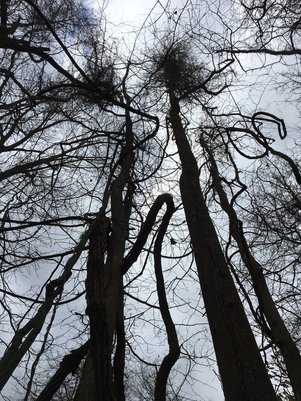 During winter it’s easy to see the damage vines inflict on trees as they stretch up and out over the tree’s canopy. (Picture curtesy of Fyrne Lake) During winter it’s easy to see the damage vines inflict on trees as they stretch up and out over the tree’s canopy. (Picture curtesy of Fyrne Lake) Too many vines and not enough time. Vines literally covered parts of our farm when we purchased it. Well, they still do in some areas. Kudzu was the main culprit. But there are several others that pose a danger to the trees of my precious forest. Yes, I said precious. Please don’t laugh or call me a tree hugger (that term has other connotations). But, you can call me obsessed. I truly love my woods and am driven to protect and defend it. Most vines are my enemy. I’ve written before about my fight with kudzu. Wherever it starts soon becomes nothing else. It’s like a cancer that climbs and smothers trees until they die and eventually fall. In the June/July 2012 issue of this magazine I shared my battle with this invasive species (also posted on my blog @ www.fyrnelake.com). This article is the first of a series that will share with you my experience with other damaging, and in some cases threating, vines. How can a vine be threating you ask? Have you ever gotten poison ivy? If you have, you know what I mean! Except for the few lucky immune individuals, the oil of the poison ivy plan is an extreme irritant. This oil is called urushiol and is also found in poison oak and poison sumac. This oil is found on and in ALL parts of these plants, even their roots. According to The American Academy of Dermatology, 85% of us are allergic. I wish I was one of the lucky ones that wasn’t. For some reason I had avoided a reaction to poison ivy most of my life. So I wasn’t that worried about it on my first solo weekend camping trip on the farm. It was within the first few months after we had purchased the property. I was excited! Most of the farm was an unexplored wilderness to me. I was more than anxious to get started and I was prepared for the adventure! I had an aerial photograph to guide me, compass to keep me on course, camping gear for comfort, and a camera to record the adventure! The property was massive and covered with intersecting wooded gullies, meandering ridge fields and a central mile long lake. It was early summer and the foliage was thick! I chose to start walking along a ridge field looking for an easy entrance through the thick briars and into the woods. Often I would see vines climbing up the trees above the briar wall. In some cases these vines were covering the trees much like kudzu will, however, it wasn’t kudzu. I eventually decided to just push through the barrier into the woods. Much to my relief, the undergrowth opened up under the tree canopy. It was breath taking! I absolutely loved it. I felt alive and excited about exploring more! I began descending the aggressive slope of the first gully, hanging on to one tree after another to steady my footing. Once I reached the bottom I had a choice, follow the gully or ascend the other side. I looked at my compass, I had a destination in mind on this hike… to find the farm’s northern boundary. To do that I needed to climb. When I made it to the top it was time to descend again. I grabbed a tree and headed down into the next gully. Each successive gully had its own secrets to reveal. I discovered majestic oaks, expansive bottomland covered in horsetail, 100 foot tall cottonwoods, hints of old logging roads, exposed veins of gravel and oozing mineral springs. Eventually my search paid off. I found traces of a barbed wire fence running east and west. This must be it! I changed directions and headed west trying my best to follow what wire I could find. It was now getting late and I needed to make my way back to camp before I lost whatever sunlight was left. By then, the hill climbing was getting to me and I found myself taking more rest breaks. While catching my breath, I scanned the forest and began noticing random vines climbing trees. Many of the vines were 2-3 inches in diameter while a few reached 8 inches or more! Looking up, I observed how once these vines reached the tree canopy, they stretched out over the tree branches blocking out much of the light. As I walked, I came across breaks in the canopy were vine covered trees had fallen, taking the vines with them. These vines were killing the forest! I knew that kudzu could quickly cover and kill a tree, but these vines were doing the same, although much slower. But why? Unlike kudzu, these wild vines were native to west Tennessee. Why were they taking over like an invasive? I intended to find out why and what I could do to defend my new sanctuary, this beautiful forest! I finally made it back to camp, built a fire, grilled a couple hotdogs on a stick and then reflected on the day’s adventures while drifting off in my sleeping bag. The next morning I was in for a surprise! I awoke with an itch that seemed to be spreading. Soon a rash appeared… I had poison ivy!!! And it wasn’t just in a few places, it was spreading everywhere! On my arms, neck and face… on my legs, feet and back. Before I made it home it had spread to my scalp. It was horrible! I couldn’t have gotten it on more areas of my body than if I’d tried! It was like I had taken off all my clothes and rolled around on it. The meds I found at the drug store for treatments at most helped with the itching, but it was getting worse. So, I broke down and visited my doctor. He put me on steroids which, with time, took the fire out and faded away the rash. But, now I was worried. I just took out a huge mortgage to purchase my dream property and I was allergic to it! I had to find out what happened and how I could prevent it in the future. I retraced my steps from the day before. Had there been poison ivy vines on the trees I used as support on the slopes? Did I take a rest break or two in a patch of ground ivy? I definitely touched it somewhere… but not with every part of my body! After talking over the day with my father, he came up with a theory. The first question he asked me was, did I wash up once I returned to camp? No, I had not. I was camping. The little water I had I was saving to drink. THAT, he said, was the beginning of my problem. He explain how poison ivy’s urushiol oil can easily get on you by simply brushing up against it. If you break or cut a vine the oil will spray out toward you. The oil doesn’t even need to touch your skin. It will stick to your clothes. OH NO! MY CLOTHES! I had slept in my clothes! I had gotten into my sleeping bag fully clothed and removed my pants and shirt after I warmed up. By the time they were off the oil had spread throughout the bag. No wonder I had poison ivy everywhere. I was determined NEVER to let this happen again! Were there other ways I could get it? How much time did I have to wash the oil off before it was too late? And, what was the best way to remove this allergen from my skin?
The reality is there are several ways to get poison ivy without directly touching it. I discovered that besides getting the oil from yours or someone else’s clothing, touching a used garden tool, weed eater or lawnmower that has cut poison ivy, oak or sumac can transfer it to your skin. Even a pet or trail bike can pick up the oil. My wife loves her dogs and has often gotten poison ivy on the inside of her wrists from greeting one particular dog as he returns from running free in the woods. However the worst way to be exposed is through fire! Burning a log with poison ivy vines attached, no matter how dead they look, will add their oil to the smoke. Inhaling this smoke can cause a severe reaction that will require seeing a physician, maybe even a trip to the emergency room! The Mayo Clinic says that the urushiol oil will begin bonding with the skin within 30 minutes. A commercially available ivy wash recommends washing your skin vigorously for two minutes within 2-8 hours after exposure and rinse with cool water. Obviously, the sooner you can wash after being out in the woods the better. While I was doing my research, an image from my childhood kept creeping into my mind. I have to admit, it was a little traumatic. We were visiting my grandparent’s farm in Indiana and my brother and I were waiting in the car while my father and a couple of his friends were in the woods hunting mushrooms. When they emerged my father immediately started stripping down to his underwear and made a bee line for a nearby stream. There he began smearing his body from head to toe with mud! My father wasn’t known for being shy, but this even took his friends (and me) by surprise. Noticing their stares he explained that the woods had been full of poison ivy and it was impossible to avoid it while gathering the mushrooms. The mud, he said, would wash off the poison ivy oil. This country remedy apparently worked. He never got poison ivy. Now, 40 years later, I’ve recovered from that childhood experience and was ready to see if a mud bath might help me overcome my current challenge, dealing with poison ivy! I’ve come to find that a lot of country remedies square with science and this just might be one of them. The commercial wash mentioned above is a suspension, meaning it requires shaking to mix up the small particles it contains before use. This product was very much like a thin light colored mud my father used. Hmm… This commercial product stated that it bonds with the oil and helps to lift it off the skin so it can be washed away by cool water. The cool water is preferred to warm because warmer temperatures would thin the oil and spread it out exposing more of your skin. The stream my father used to wash the mud off was obviously cool, maybe even cold (I remember him shivering). Maybe the slightly abrasive mud combined with cool stream water is just as good as or even better than the store bought remedy! Well… It was worth a try! The next chance I had I used mud. Even today, I use mud when I don’t think I’ll have enough time to wait for a shower. So, do you want to know if I ever stripped down for a mud bath??? The answer is yes! However, most of the time I’d simply take off my shirt and smear my arm, neck and face. I have to admit, it worked every time! What has kept me from having to take mud baths very often is wearing (and washing after use) the proper protective clothing while in the woods. No matter how hot it gets, I always wear boots, jeans, gloves, wide brim hat and an unbuttoned long sleeve shirt over a T-shirt. This provides a barrier for my skin from ivy oil exposure while also shielding me from most insects and briars. Poison ivy vines are a nuisance to humans. But with proper preparation, caution and care severe reactions can be avoided. The good news is poison ivy poses hardly any threat to my precious trees. Their vines simply use their trunks and branches for support and typically stay beneath its leaf canopy making it harmless to the forest. Other vines pose a greater threat. In my next article I’ll explain this threat, why it’s worse now than a generation ago and what I’m doing to fight it. Until then, try not to think about seeing YOUR father stripped down in a mud bath! 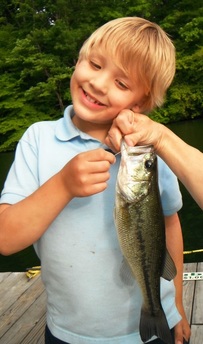 At 7 years old Andrew, my youngest son, just caught this bass using a tadpole as bait. He did everything on his own from baiting the pole to reeling it in… except, I still ended up unhooking the fish. At 7 years old Andrew, my youngest son, just caught this bass using a tadpole as bait. He did everything on his own from baiting the pole to reeling it in… except, I still ended up unhooking the fish. I love fishing with kids! Especially when I can give them a great experience… like actually catching one! Nothing hooks a kid on fishing more than having ANY fish strike their bait, pull against their line and then successfully land the finned creature. The smile on the child’s face tells the tale. They are ready to come back for more! That usually excites the adult fisherman in the picture as well. They’ve just gained a new fishing buddy most likely for the rest of their lives! Do you love fishing? Do you want to share this love with your child, grandchild or family member? Do you want to create a new fishing buddy? Maybe I can help. I’ve had the privilege to host many groups of kids at Fyrne Lake and that has blessed me with years of experience in getting children hooked on fishing. Perhaps some of what I’ve learned along the way will help with your fishing buddies. Even before you put a pole in their hand it’s important to make sure they are comfortably dressed and you have sunscreen and bug spray available if needed. It also wouldn’t hurt to have a bag of snacks and a cooler of drinks nearby. There’s nothing that will end a fishing trip with kids quicker than a swarm of mosquitos or a growling stomach. Also, you’ve got to go into this experience with your long-term goal in mind… to create a fishing buddy. That means you’re their expert guide and fishing tackle slave. Be ready to keep their hook baited, line untangled, snags unsnagged and catch unhooked. You may not even get to wet your own line! You’ve got to be OK with that or you’ll find yourself getting frustrated and distracted from your mission at hand. 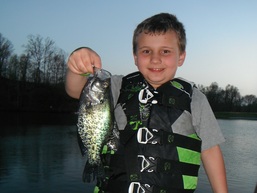 Mason Mullens is holding his prize crappie landed during a father/son fishing trip with his dad, Gene Mullens, on Fyrne Lake in 2014. Mason Mullens is holding his prize crappie landed during a father/son fishing trip with his dad, Gene Mullens, on Fyrne Lake in 2014. Even though I own Fyrne Lake, I would still recommend taking your child for their first experience to a small private pond where the fish are fed or a pay catfish pond. That will insure their success. However, I know they’re not always nearby or available. It’s still very possible to have a good 1st time fishing experience in larger natural lakes like Fyrne Lake. It will just be more of a challenge for you to guide the fish to their pole. The fish in Fyrne Lake are totally wild and prefer striking live or naturally appearing and presented artificial bait. My recommendation is to start out with live. Making fishing lures move naturally in the water takes more finesse than most beginning fisherman can master. Live bait is also more interesting to kids. Holding a squiggling worm, chasing an escaped cricket or playing with minnows in the bucket can maintain the child’s interest between fish bites. However, using live bait is not a guarantee of success. Presenting live bait in a productive way can be challenging. Luckily my father, Kenneth Griffith, taught me several basic fishing principles that still guide my personal fishing today and my efforts in helping visiting children catch fish. While I was growing up my dad drilled into me the need to minimize hardware, place the bait on the hook with purpose and cast the line in the water where there are fish. Let’s start by discussing fishing hardware and by that I mean everything going into the water that’s not living. When fishing with live bait, the lighter the line and the smaller the hook, the more quickly a fish will bite. Obviously, lighter lines require less tension on your drag and the hook used needs to be an appropriate size for your bait. It’s also important to use just enough weight to get your bait to where you want it and just enough float to keep your bait suspended from the surface. Too much hardware discourages bites and may cause a fish to let go once they feel the resistance of excessive weight or an oversized float. 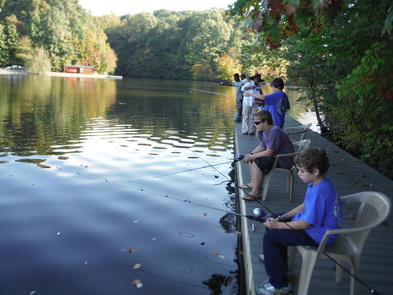 Boy Scouts are shown beginning their day fishing off the pavilion dock at Fyrne Lake. Boy Scouts are shown beginning their day fishing off the pavilion dock at Fyrne Lake. Properly placing your bait on the hook is just as important. This is especially true when using minnows. Done properly, minnows will do all the work for you as they desperately swim against your line appearing to be in distress and an easy meal to any nearby game fish. There are many ways to hook a minnow. For me, when fishing from shore or an anchored boat (not trolling), the best place to hook the minnow is under the dorsal fin trying to just get under (not through) the bone. It takes a little experience with each type of minnow to identify just how far below the fin to go. Too far and you weaken the fish, not far enough and you’ll quickly lose your bait. It’s also important to match the hook to your fish. I choose a hook 1-1/2 to 2 times as wide as the back of the minnow is thick and enough loop to the hook to allow the barb to be fully extend above the bait’s back. Crickets and worms are much simpler to successfully hook and present. Most any method will pique the interest of a pan fish. The challenge here is to hook them before your bait disappears! I hook crickets under their chin and out through the belly. I prefer to use a thin wire hook with a shank just long enough to extend above their head and barb loop wide enough to slightly extend out of the insect’s body. This method keeps the cricket active and on a hook that will easily fit into the small mouth of a bream. Worms are even easier to successfully hook. As long as some of the worm is near the hook’s barb, you’ll have a good chance of hooking a fish. However, bream are expert worm thieves! They seem to know exactly where your barb is and will yank it off from the worms dangling end. If this happens to you, use a smaller hook and less worm! I hardly ever use a whole worm when fishing with kids. I’ll typically cut off about one inch of worm and thread it over the barb leaving only a quarter to one half inch of worm dangling. If the fish are still winning the battle I’ll reduce the size of the hook even further and leave even less or no worm dangling. I’ve been known to go all the way down to a size 12 hook before landing my thief! Having a perfectly baited hook and a minuscule amount of hardware alone will not guarantee success. You have to fish where the fish are! Casting your line out toward the middle isn’t going to accomplish anything unless there is structure present or obvious fish action on the surface. The best place to cast may only be 3 feet in front of you! It all depends on the location of the structure. Because where there’s structure, there are usually fish! At Fyrne Lake we’ve purposely placed structure around our docks and shoreline fishing spots to attract fish. There’s a combination of natural tree branches, porcupine fish attractors, pallet stacks and Christmas trees. These structures attract and hold baitfish, bream and larger gamefish. That helps me insure they’re fish around when kids visit. Wherever you fish, simply fish near any structure you can identify; fallen trees, water plants, stumps, docks… anything from vegetable to mineral items in the water may hold fish. If there’s nothing visible, treat the bottom as your structure. Fish will graze along the bottom looking for anything that looks alive and/or edible. The key here is to suspend your bait just above the bottom, not on it. Too high and your bait will be missed, too low and it will be lost in the muck on the bottom. The depth you suspend is also important if you see obvious structure. The most productive depth placement of your bait is suspended just above, beside or slightly under structure. Once you’ve set the depth of your bait below the float you’ll need to cast your line as close as you can get to your targeted structure without snagging. The reality is you’ll snag it often. Not only because you or your young one is working on casting accuracy, but because you’re learning how deep and how much of the structure extends beyond what’s visible. Don’t fret about it, losing tackle is just a part of the adventure! Now you know all you need to know to help kids catch fish except… how to set the hook. Kids get excited when their floats go under and will frantically reel the line in often pulling the bait right out of the fish’s mouth. The following simple instructions my father shared with me 50 years ago have helped countless young children successfully hook and land fish. 1) Point the tip of the pole toward the float. 2) Wait until the float is fully submerged. 3) Reel in until the slack in the line is gone. 4) Without jerking, firmly raise your pole tip up. 5) Without rushing, steadily reel in keeping the line tight. 6) Get the fish securely on shore, on the dock or in the boat as soon as it reaches you! My dad’s favorite pastime is fishing and he passed it on to his kids, including me. Thankfully, he taught me what it takes to teach children how to fish and in the process creating future fishing buddies. Now you can create your own and pass on your love of this awesome sport! 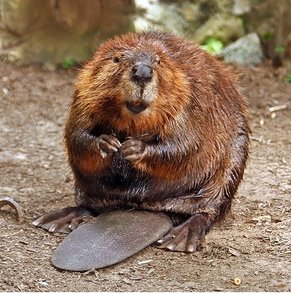 American Beaver (from Wikipedia) American Beaver (from Wikipedia) Success!!! Yes, I finally achieved success in my battle with muskrats in Fyrne Lake. If you remember my last article (May-June 2016 issue), I had laid out my problem ... way too many muskrat and beaver had taken up residence in our lake. They were causing shoreline erosion, threatening our dam through burrowing and preventing me from introducing aquatic plants as fish cover by consuming them in short order. I needed help and found it with Johnny Copeland with Copeland Beaver and Critter Control. He spent several weeks placing and baiting ingenious trap sets (many described in my last article) that fooled a substantial number of muskrat. But what about my beaver problem? Beaver are the larger cousin to the muskrat and are by far the most destructive. They’ll flood bottomland with their dams killing crops and forests, block overflow pipes in catch basins, ponds and lakes, kill trees by cutting them down to eat their bark. They also create bank erosion and damage impoundment dams through burrowing. All in all, beavers are a persistent and reviled enemy of farmers, foresters and pond owners. Fyrne Lake was no different. During Johnny’s investigation he identified multiple dens around the lake and several beaver dams along the outflow creek. As if their shoreline damaging dens surrounded by felled trees weren’t bad enough, the dams they constructed along the creek were backing up a substantial body of water stretching for several hundred feet. This was bad! The beaver were already using their new transportation highway to transport their recently felled trees. Something had to be done! Left to their own devices these beaver could expand their structure to flood several acres of hardwood forest. Johnny knew exactly what to do! After surveying the lake and outflow creek he went about setting multiple traps and snares. However, to be successful you need more than these two tools. You need to understand your target. Every species has their unique behaviors, but all animals are creatures of habit often following the same pattern day after day. Animal also tend to travel the path of least resistance. When a large branch blocks their normal path, rather than push through the obstacle, they tend to go around it. These facts combined with his intimate knowledge of beaver behavior guide Johnny’s trap and snare placement. Johnny’s trap of choice for beaver is the Conibear spring loaded 330. It’s an instant kill trap that’s powerful enough to kill a large beaver, but sensitive enough to trip and dispatch a juvenile muskrat. These traps are also very dangerous to humans. More than one absent minded trapper has suffered a broken bone or severe bruise from one. It takes skill and experience to safely set a 330 without endangering yourself and still have a good chance of capturing your target. With an eye toward safety, Johnny carefully set these traps along likely travel paths near identified den openings, beaver runs and dams. To increase his likelihood of success, he positioned obstructions on each side in the hopes of directing his prey toward the opening of the 330. For insurance he placed a small drop of beaver castor, his secret weapon, on the tip of a stick just beyond each trap. Castor is obtained from the scent gland of the beaver which secretes this yellowish oil while urinating to mark their territory and attract mates. It has a potent smell that’s sure to be noticed by any nearby beaver, often luring them to check out why the scent of a stranger is in their territory. The spring loaded traps, like the 330, work well most of the time. However, there’s always that challenging animal that seems to stay one step ahead of you. Like a 10 pound bass or a 12 point deer, there’s a reason some beavers live to become old and large… they’re smart! Most every trapper has been challenged by a granddaddy beaver consistently avoiding their traps. I think these professionals look forward to it! It’s the challenge of conquering an intelligent foe that makes success all the more sweet for any hunter or fisherman. I bet many of you have experienced the total exhilaration found pursuing a trophy deer or monster fish. Every time I take my fishing pole down to the lake and slip the line in the water my heart races. My mind reflects back on the years of discovering which baits work when, where to cast, how to present and when to set the hook. Occasionally this experience mixed with a little luck pays off with a trophy fish. I’ve also seen a good friend, who’s an experienced hunter, spend all summer identifying the territory and tracking the habits of a trophy deer to only be outsmarted during hunting season. Undeterred, he pursues his prey the following season and if necessary the season after that. The thrill of the pursuit is reward in itself. Johnny experiences the same excitement while pursuing beaver or any of the other unwanted species he’s asked to remove. Whether it’s a pack of coyote terrorizing a farm or an elusive raccoon that’s taken up residence in an attic, he’s enjoys learning their unique habits, strengths and vulnerabilities to bring his customer’s varmint issue to a successful conclusion. My beaver challenge was no different. Fyrne Lake was infested and had several established beaver families containing a few smart and huge individuals. Johnny wasn’t taking any chances. Rather than wait to be outsmarted, he mixed in several snares among his trap sets. Traps like the industrial appearing Conibear 330 are a challenge to conceal while snares, consisting of just a single cord or cable, blend in with their surroundings and, when properly set, are extremely effective. Snares are one of the earliest methods of trapping. They utilizes a cord that incorporates a slipknot which will tighten around the head, body or limb of an animal like a noose as they move through its opening. These effective devices have been made from vine, horsehair, woven twine or whatever locally available material can be fashioned into a cord. Today’s modern snares are often made of metal cable that are available in different gauges (diameters). For beaver Johnny prefers a five foot long, 5/64” diameter cable. Occasionally he’ll attach a 5 to 10 foot cable extension to reach an anchor point. Johnny emphasized to me the importance of proper anchoring. Beaver can chew through a sizable tree overnight. However, they only chew down to about 6” above the ground. Anchoring below this point is vital for consistent success. How and where you set your snare is just as important as how you anchor it. After surveying the area, Johnny knew exactly where he wanted to set his first, near a large poplar tree along Fyrne Lake’s outflow creek. The beaver had been working the tree for several days, chewing off its bark in a complete ring around its base. This poor tree was doomed! Even if the beaver don’t cut it down completely, they had already cleanly chewed through the sapwood layers located between the bark and heartwood. These layers contain the functioning passageways that transport fluid and nutrients from the roots to the branches. Now, everything above the cut was starving and would soon wither, die and rot. It was too late to save this poplar, but not too late to save the rest! Johnny looked for signs that would indicate how the beaver were traveling to and from the tree. It didn’t take long to notice a clear, slightly worn path starting at the tree’s base, along the shoreline and extending into the creek. He prepared his snare and waded out into the creek. After securing one end to a solid anchor point, Johnny mounted its opening vertically and half submerged directly in the path the beaver had been traveling. With one down, he moved on to his second snare set where he planned to used his prey’s dam building instincts against them. He was going to breach their dam! Johnny approached the beaver’s main structure, walked along its top and carefully selected the exact area for his attack. Quickly, he dug a trench through the dam’s top extending several inches below the waterline and placed a snare vertically in the middle. He then placed branches on either side and above to guide any beaver attempting to repair the dam right through the middle of the snare. With his traps and snares set, he returned home. Trapping takes patience. Even the best set trap or snare doesn’t always produce results. Over the next couple weeks Johnny ran his trap lines, sometimes with his son, Drake. Johnny shared with me how trapping is a dying art and he was blessed to be able to teach Drake this skill and its importance, not only to farmers and property owners, but for the environment itself. Development and human activity has created predator/prey wildlife imbalances that can lead to starvation, disease and over population. Trapping (as well as hunting) can be used to manage wildlife species within a specific habitat to create a healthy balanced and diverse wildlife population. Success! Johnny and his son’s efforts paid off! Numerous beaver along with a good number of muskrat were removed from Fyrne Lake. I’m glad I swallowed my pride and called in an expert. Any professional worth their salt will save you more time, money and effort than they cost. That saying now applies to Johnny. Thanks to his expertise and hard work ZERO beaver have been spotted in the 6 months since the trapping. That’s SUCCESS! Left - Muskrats measure from 16 to 28 inches in length, half of that being the tail, which is used as their main means of propulsion. Picture from Wikipedia and taken by D. Gordon E. Robertson Middle- Here's Johnny preparing to set a carrot baited 110 Conibear trap. Photo by author. Right - Johnny points out fresh muskrat droppings, on a floating log that's crying for a log set! Photo by author. Do you remember my muskrat problem? A couple issues back I reveal my greatest failure (to date) in my efforts in managing Fyrne Lake. After months of research, visits with two lake management consultants, hours of reading research papers on the internet and sifting through a pile of pond management magazines I had pieced together my management plan. I was excited and ready to jump in. The plan involved removing unwanted fish (small bass, stripes and catfish), adding 1000s of crappie each year, stocking a variety of baitfish species and adding artificial and natural structure. All areas were progressing well except for one, adding natural structure. Dropping trees in the lake and creating brush piles was simple, but in a 110 acre lake with almost 8 miles of shoreline it wasn’t humanly possible to add all the natural structure the lake required. Plus, while the trees, branches and artificial structure I was placing in the lake was great cover for bass and crappie, they provided only moderate protection for baitfish and gamefish fry. The only real long-term solution was adding aquatic plants… acres of them! The right combination of aquatic plants would form a dense protective nursery along the shoreline of Fyrne Lake to maximize baitfish reproduction. Then this abundant food supply would fatten up our gamefish to enviable sizes. At least, that was the plan. I had picked out several plant species that would fill the bill and not threaten to take over the lake’s surface by stretching out into open water. I had done my homework, purchased my starts and planted them behind protective fence circles to give them a chance to establish. At that point the battle began. The muskrat, being smarter and more agile than the 40+ pound grass carp that inhabited Fyrne Lake, soon learned they could climb over the fence and consume my expensive salad. A couple years of battles ensued between me and the muskrats. Bottom line, THEY WON, I LOST. After countless hours of effort, various fencing designs, multiple shipments of plant starts and way, way too much time and money, I surrendered. There were too many intelligent rats in the lake and only one of me… and they had figured me out! Now, my story doesn’t end there. No, I shared the paragraph above to bring you up to date on where the situations stood in January of this year (2016). Several years have now passed since my last battle with these challenging creatures and they have been happily going about what muskrats do so well, eating anything green in the lake that the grass carp didn’t get to first! There bigger cousin, the beaver, had also moved into the lake. Between the two of them, the lake was becoming crowded and damage was becoming evident along the shoreline with dens, damaged trees and the continued absence of aquatic plants. I even found evidence of a muskrat den along the dam! This was dangerous! Beaver and muskrat can burrow completely through an earthen dam causing severe damage, weakening the dam and requiring immediate repair. Luckily, I caught this burrow early. But, the danger wasn’t going to go away on its own. It was time to call in reinforcements! I called Kelly Locke, who handled the pest control on our farm. He didn’t trap aquatic mammals, but he knew who I should contact, a gentleman by the name of Johnny Copeland at Copeland’s Beaver & Critter Control. Johnny grew up trapping alongside his father. It’s in his blood. Trapping to him is like fishing or hunting to most of us. It’s his chance to get out into God’s creation, enjoy its beauty and absorb the peace of God’s presence. Like us, it’s icing on the cake to actually catch, shoot or trap something. Right now, Johnny has a day job. But he dreams about eventually growing his trapping business into a fulltime job and from what I’ve seen, I believe he will achieve his goal! He’s already providing beaver control for several farms, predator control for multiple land owners and building a growing list of satisfied customers where he’s removed unwanted living (or dead) animals from in, under or around their home. He has a dream, a plan and the willingness to do the work to get it done. I don’t see how he won’t eventually achieve his dream. To do my part, I hired Johnny to thin out the muskrat and beaver on Fyrne Lake. That decision turned out to be the beginning of a whole new learning experience! I wanted to learn all about what he did and what it takes to be a successful trapper, so I accompanied him on his boat as he left the landing to scout out the lake. It was a couple hours before dark as we cruised along the shoreline looking for signs… signs of beaver and muskrat activity. He explained that beaver eat the bark, twigs and leaves off trees while muskrat consume aquatic plants (I knew that!), ground vegetation and when the opportunity presents itself, fish, turtles and invertebrates. He said to keep an eye out for damaged trees, floating branches with the bark stripped off and den holes along the shoreline. It wasn’t long before we saw definite holes in the bank right at the waterline. We slipped up to one in our boat, Johnny hopped out and then picked up a fallen tree branch to use as a probe. With it he discovered that the hole extended quite a ways back into the bank, eventually angling up beyond his reach. This was definitely created by a beaver! As we prepared to set a trap at its opening, Johnny explained that even though he was certain a beaver originally constructed this den, it may not currently be occupied by one. However, that doesn’t mean that it was unoccupied. Muskrat often move in to abandon beaver dens. The good news was that we were after both prey and Johnny set the trap accordingly. He chose a 330 Conibear instant kill trap. It was large and powerful enough to dispatch a full grown beaver, but sensitive enough to trip and eliminate a juvenile muskrat. Setting such a large and powerful trap is tricky and dangerous. Johnny, made it seem easy setting the spring tension and trigger, then staking it down in a vertical position across the den’s entrance. He then gathered random branches sticking them down on either side of the trap to eliminate gaps that our target could slip through and thereby encouraging them to take the easy route… through the opening of our trap! At that point I thought we were done and ready to move on. I was wrong. Johnny took out his secret weapon, beaver castor. Castor or castoreum is the yellowish liquid secreted from the sexual scent glands of a beaver. This is NOT the castor oil your parents or grandparents took as medicine as a child. That medicinal castor oil was made from pressing the beans from the castor oil plant (Ricinus Communis). No, this castor oil is secreted by a beaver while urinating to mark their territory and attract potential mates. The only way to get it is through removing the castor sacs from a beaver. This oil is expensive, but luckily it only takes a few drops to accomplish Johnny’s goal. Carefully, he placed a precious measure of this potent smelling fluid on the trap. Now our scent was covered and a “BEAVER HAS BEEN HERE” signal was broadcasting at full volume! On down the lake we moved, setting traps across the entrance of every promising den site. Eventually, we reached the top of the lake, a mostly shallow area where Coon Creek flows into the lake. It turns out this shallow marshy area was an ideal habitat for muskrat and beaver. The periodically flooded shoreline begins with a boggy grass buffer giving way to a stand of horsetail and grove of willow trees. Beaver LOVE willow trees and the stumps and felled trees were evidence to that truth! Droppings litter the tops of floating logs betraying the presence of muskrats. We had just found the home where most of our trouble emanated. And now our real work began. Johnny jumped out of the boat and waded along the shore. He was looking for runs. Runs are channels dug out by beaver and muskrat to move to and from the lake from their dens with ease. Right beside a log piled with muskrat droppings he found one. It was deep, much too deep to be made by muskrat. It had to be a beaver run. Muskrat are known for taking advantage of their bigger cousin’s work. They claim abandon beaver dens (as I mentioned earlier), utilize their underwater highways and even feast on the foliage of their downed trees. Muskrats have learned to take advantage of the opportunities they encounter… like my costly (and muskrat consumed) efforts at starting aquatic plants in Fyrne Lake. Yes, I needed to remove the beaver, they were the main threat to the dam. However, my more immediate target was the muskrat population. They had outsmarted me in my repeated attempts to establish aquatic plants. I encouraged Johnny to focus a good portion of his efforts directly toward my nemesis. Up to the challenge, this skilled trapper set four distinctly different types of trap settings to maximize our potential for immediate success. He first went for the floating log with the pile of muskrat droppings. He used a smaller 110 Conibear trap on the log near the droppings. He suspended the trap vertically by using two long branches threaded through each side and pushed down into the lake bottom. He then pulled out two pieces of carrot and pushed them onto the suspended trigger wires. And, of course, he added a small amount of muskrat castor. He then moved toward shore to create a pocket set. A pocket set involves creating a single path toward a bait allowing you to control how your target will approach making it easier to place the trap and ensure success. Johnny chose a large tuff of grass, created a path to the center and a pocket within. There he placed another carrot baited, castor scented 110. Then Johnny started scanning the area. He was looking for a trail on which to place his colony trap. A colony trap is a long narrow cage type live trap. Each end has a one way trap door. When located well, a colony trap has been known to catch multiple muskrat overnight. It wasn’t long before Johnny located a trail and placed the trap. The sun was over the horizon and it was getting hard to see without a light. But, Johnny wanted to place one more set. I think it was his favorite of the day. He took a 5 foot two by four board out of the boat, hammered a large nail all the way through about 4 inches down from the top until all the available point of the nail extended out the opposite side. He then took a half corn cob and pushed it long ways onto the nail point. Next, Johnny stuck the board at an angle into the creek bed in approximately 2 foot of water creating a perfect ramp for a muskrat to climb up to rest upon and have a snack. Now it was time to choose the trap. He picked up a #1 single long spring foot hold trap. A foot hold trap looks like what I remember seeing in cartoons as a child and function very much as their name implies. There are two spring loaded jaws that open to form a circle with a trigger pan in the middle. Depress the pan and the jaws close immediately upon whatever touched it, most often a foot. This type of trap doesn’t kill, and depending upon the animal, doesn’t even injure. But, it does “trap” them in place, assuming you have the trap secured well with a chain. Our purpose was to kill the animals in a humane way. We didn’t want them to suffer overnight with a trap around their ankle. Johnny accomplished this by loosely placing the trap on the board above the water line along the path the muskrat would have to take to reach the corn. The trap was attached to the board by a chain long enough to reach the bottom of the surrounding two foot deep water. If a muskrat set off the trap, both would fall in the water and the weight of the trap would hold the muskrat under until he drowned. Our first night of work was done! We had multiple traps out in a variety of sets and we did it on a beautiful and clear March evening. As we packed up the boat to head back to the landing we saw a lone muskrat in the dim light swimming across the cove not 50 feet ahead. As I watched the wake spread out as his head cut through the water I felt a tug of guilt. I had seen them as the invader… but at that moment I felt like the intruder. I consoled myself by remembering that my efforts were an attempt to protect Fyrne Lake and bring its ecosystem back into balance. Removing the over population of muskrat was key to being successful. It didn’t make me feel any better, but I knew it was necessary. I guess the question is… would this effort be successful? Check out the next issue to discover the answer. Left - Colony traps are constructed from wire mesh, with a one-way trap door located on both ends.
Photo by author. Middle - Johnny Copeland setting a 330 Conibear trap. Photo by author. Right - This picture shows a typical log set, utilizing a carrot-baited 110 Conibear trap. Photo by author |
AuthorKevin Griffith Archives
September 2018
Categories |
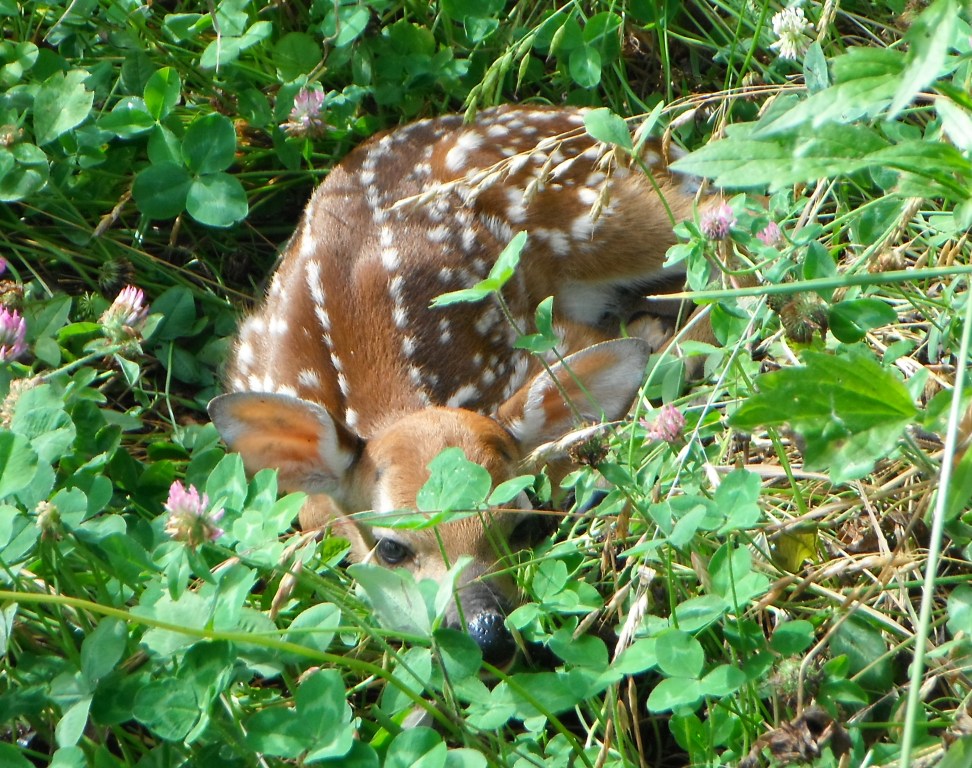
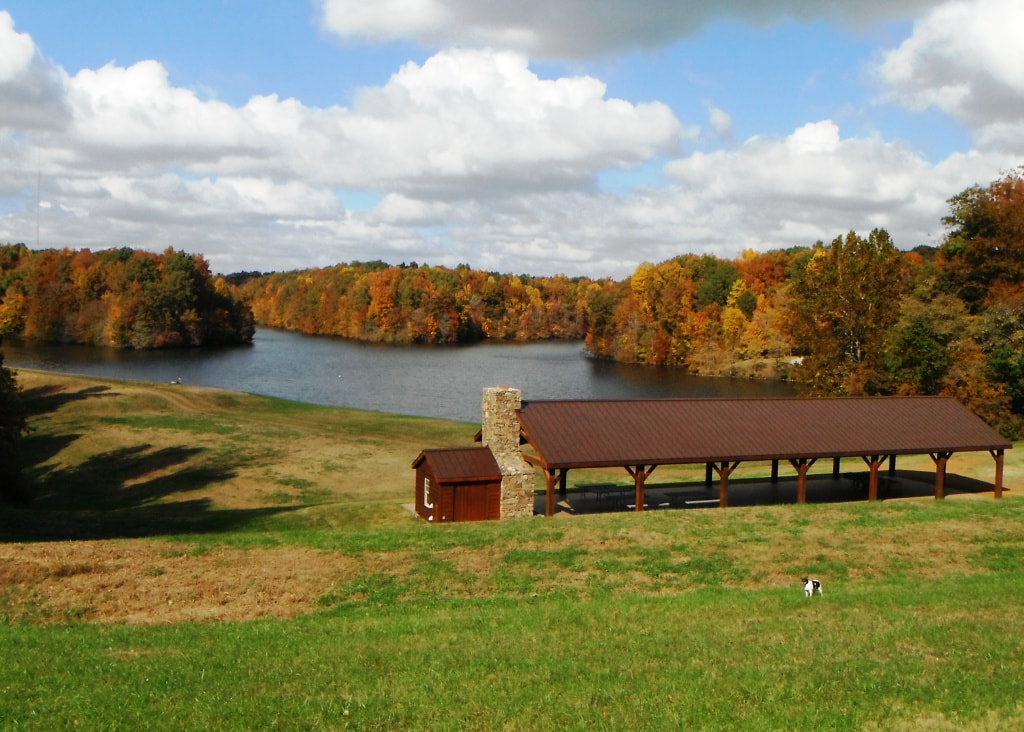
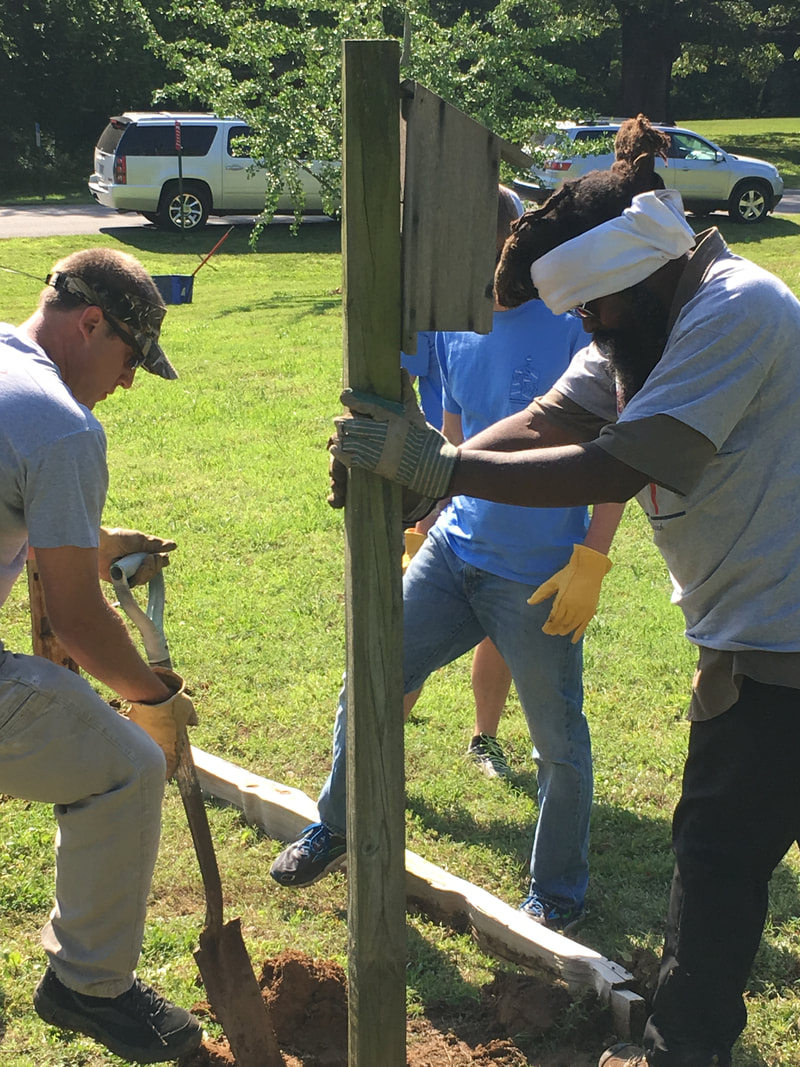
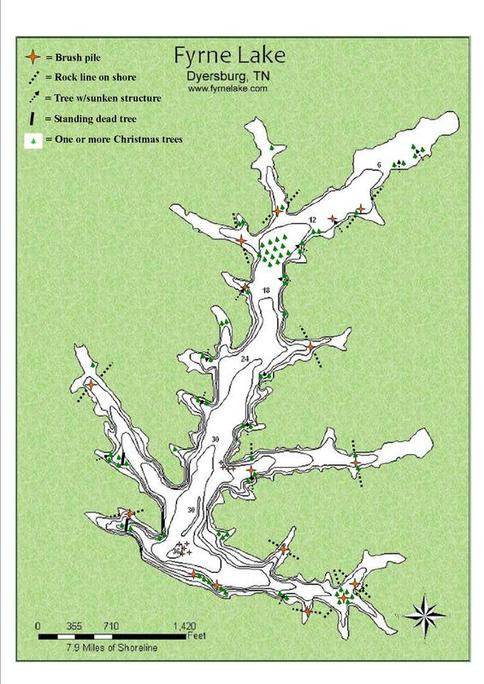
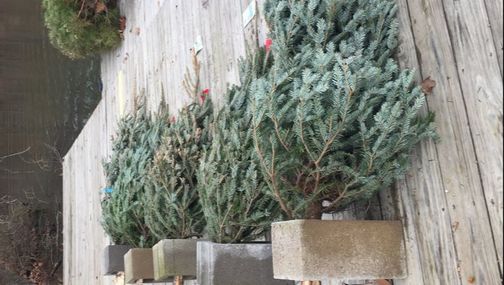
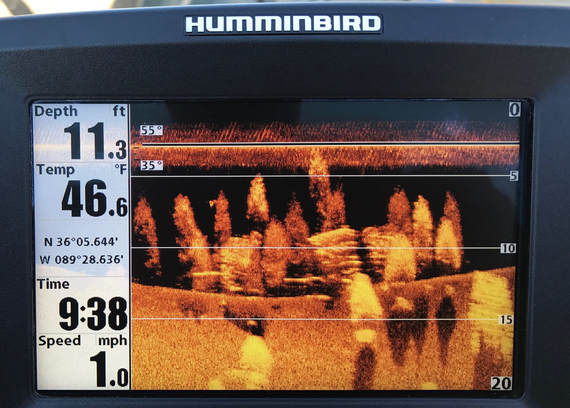

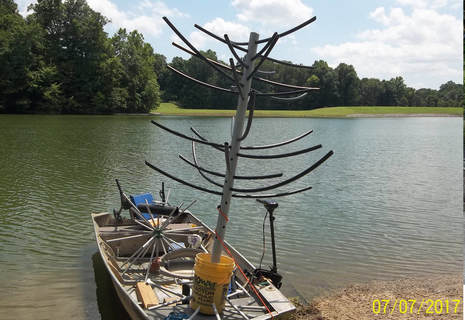
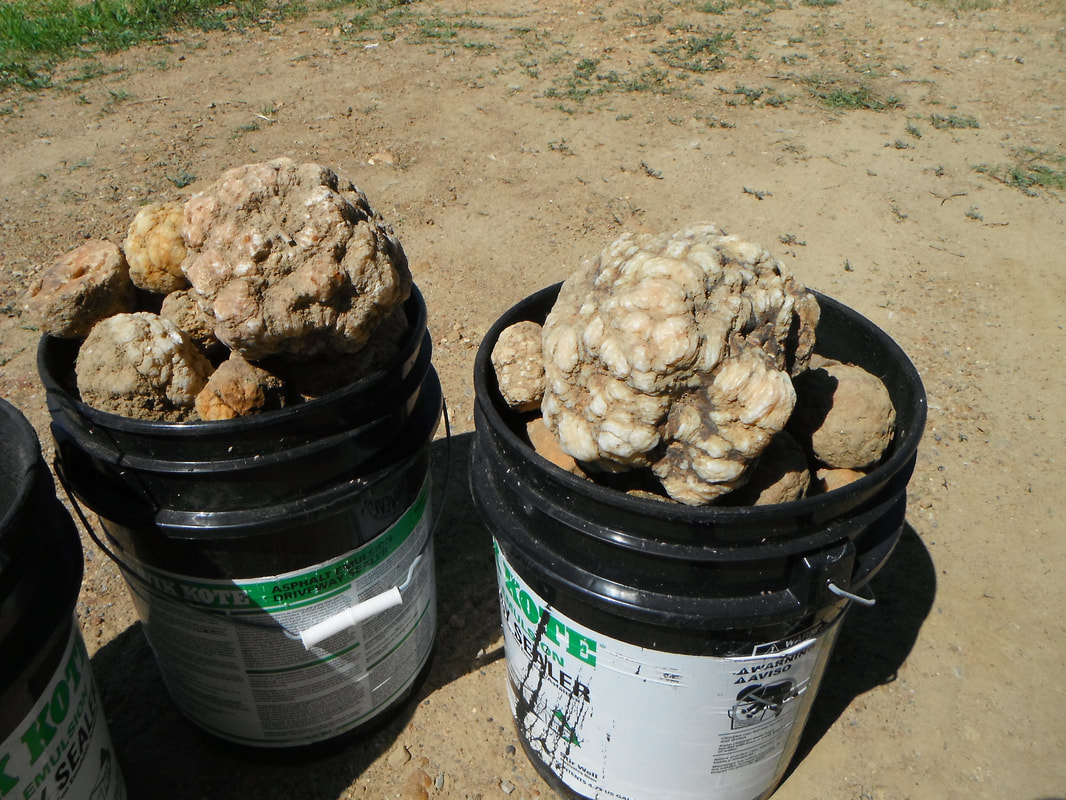
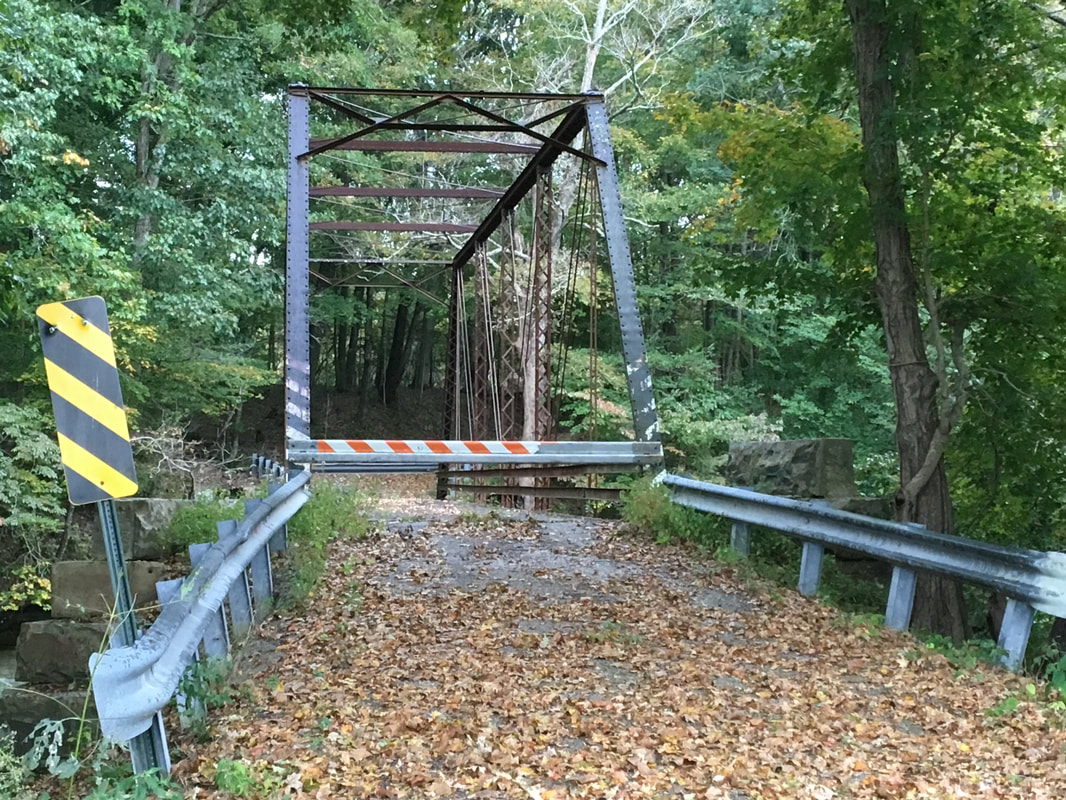
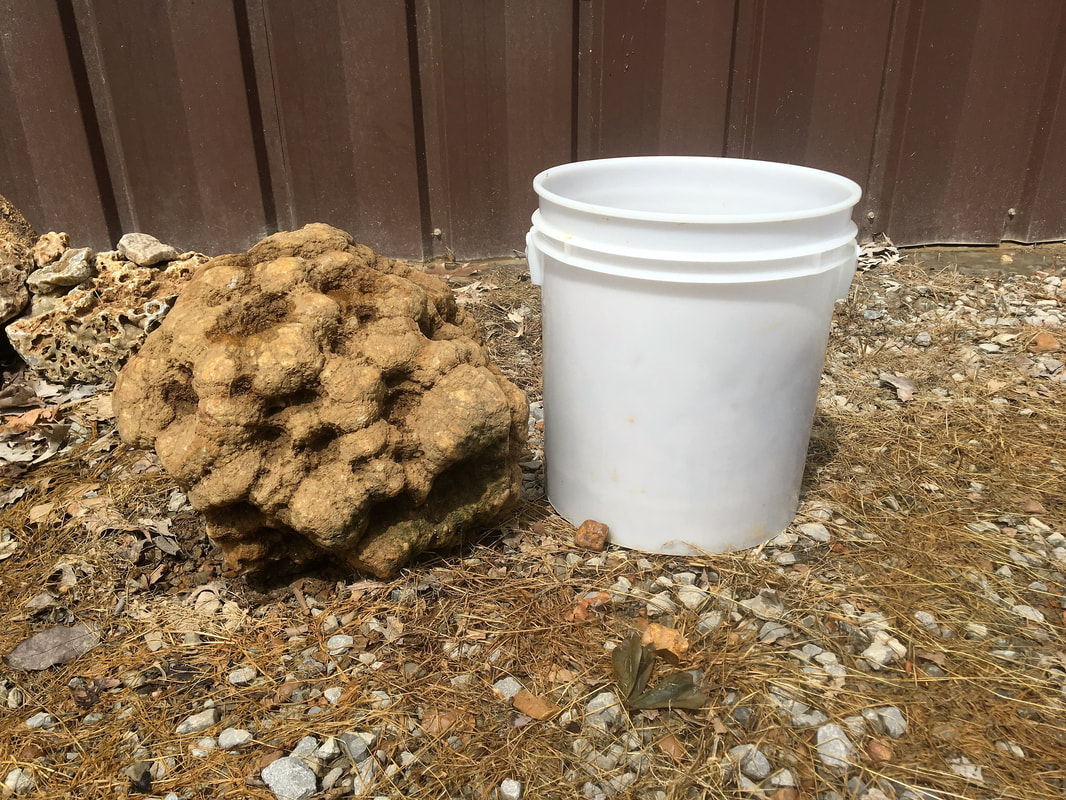
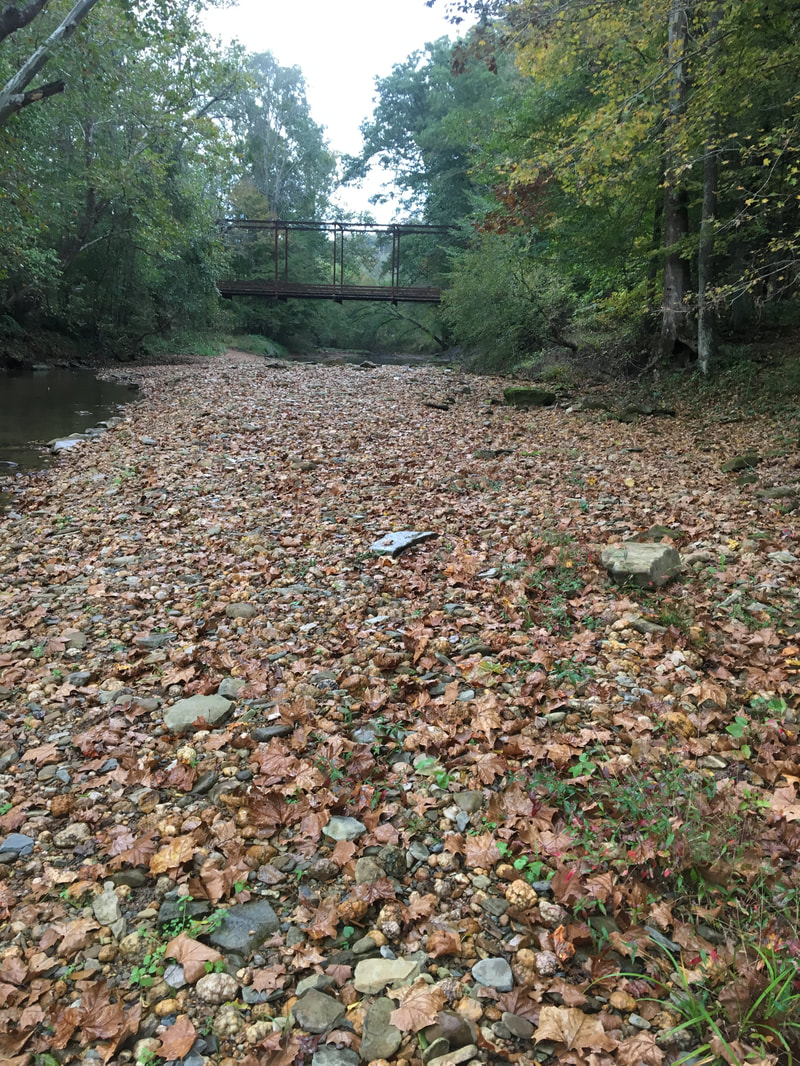
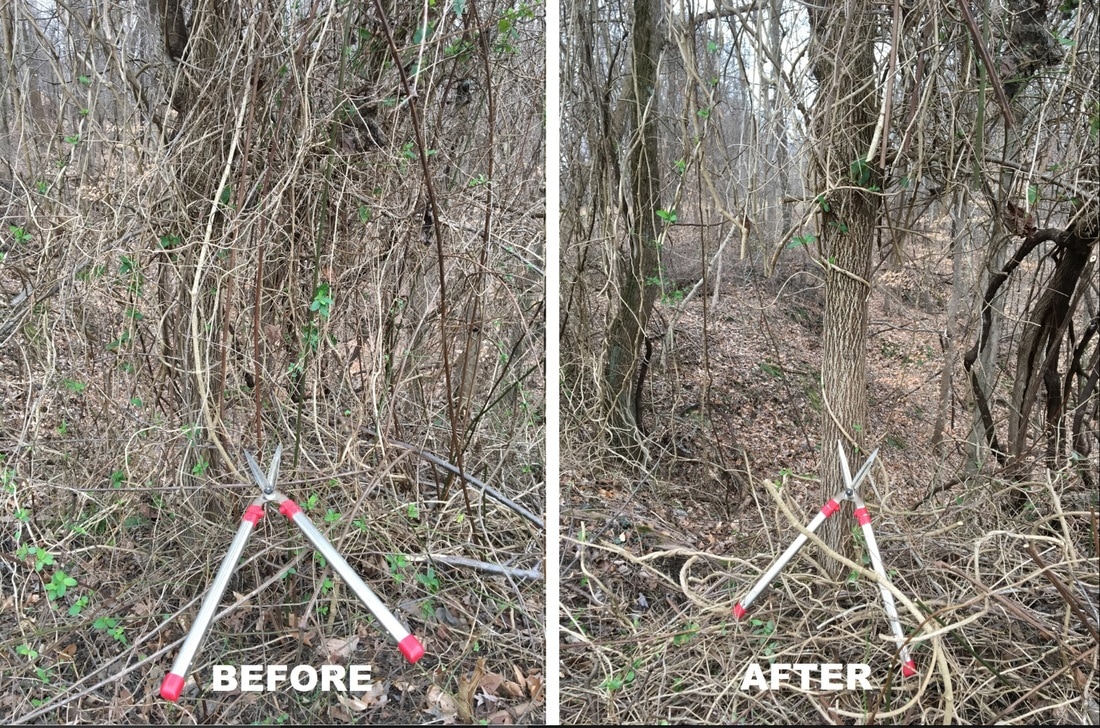
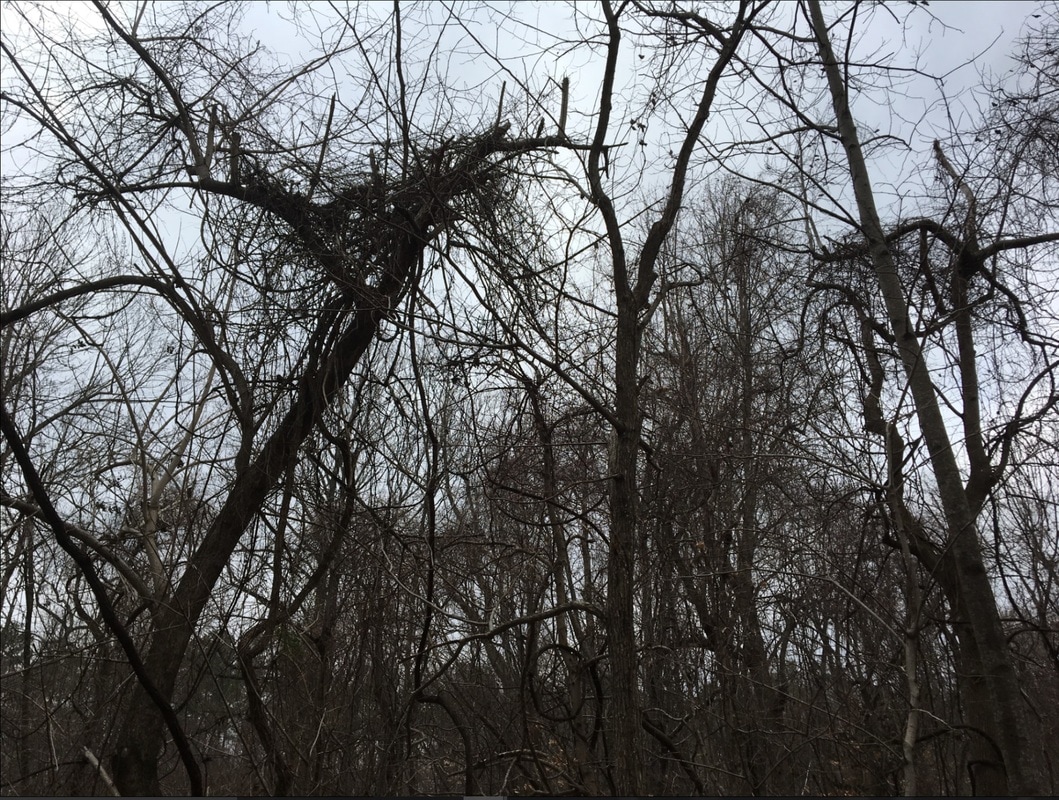
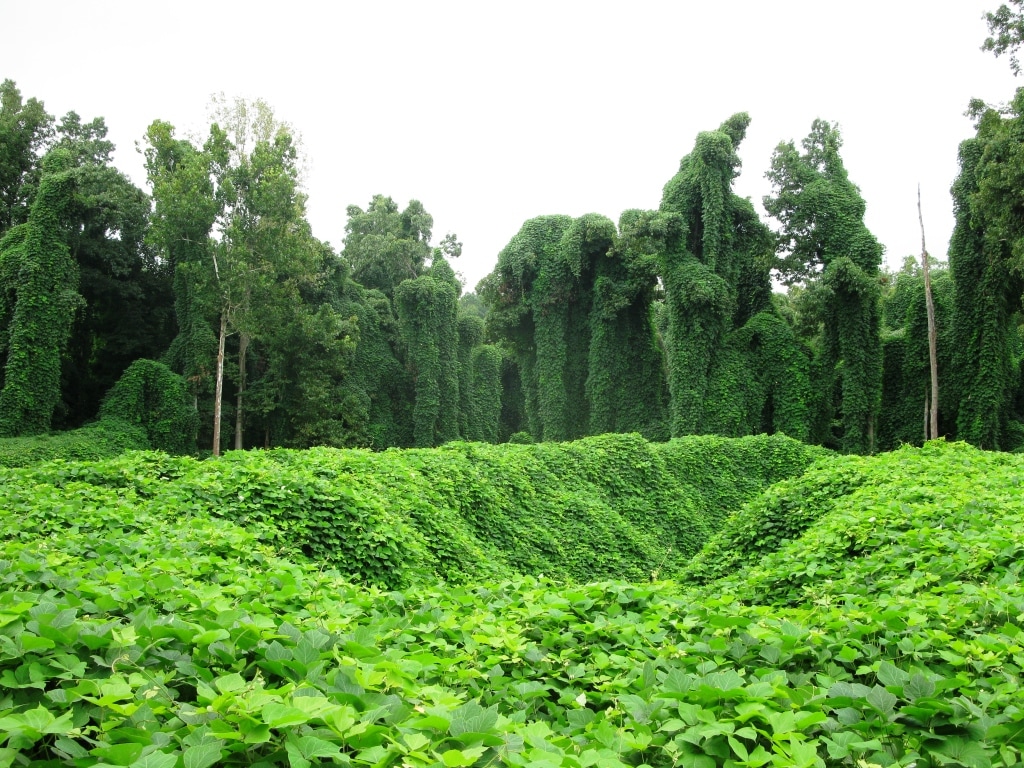
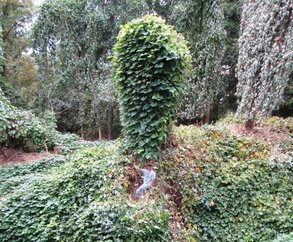
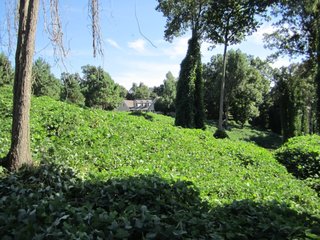
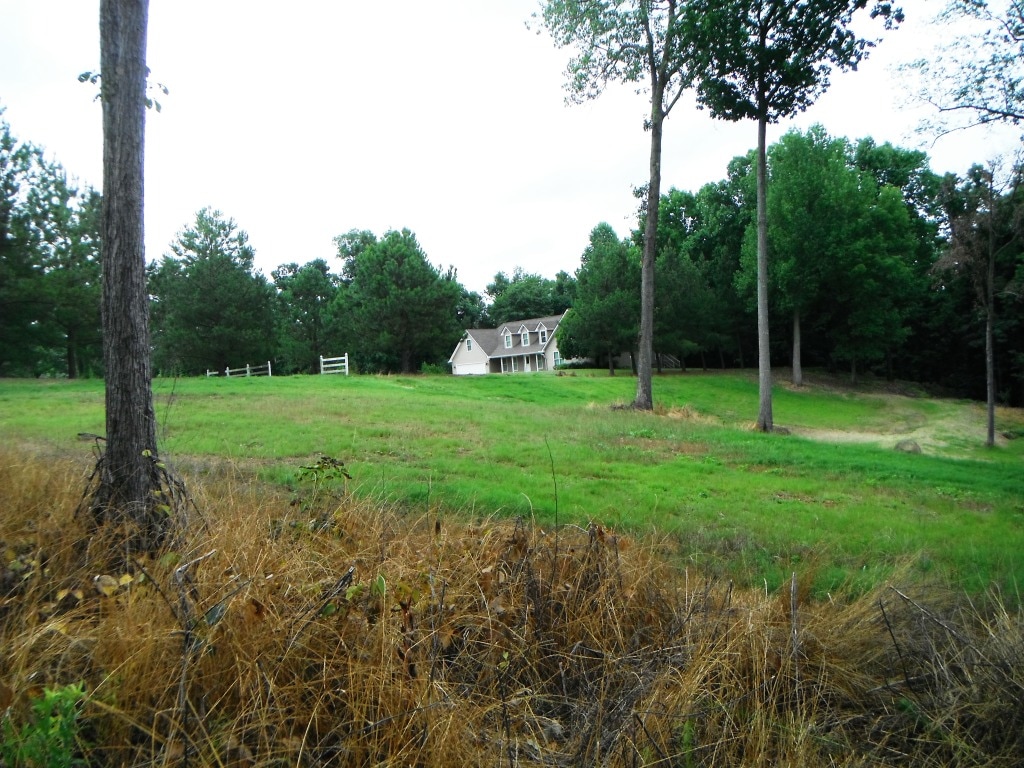
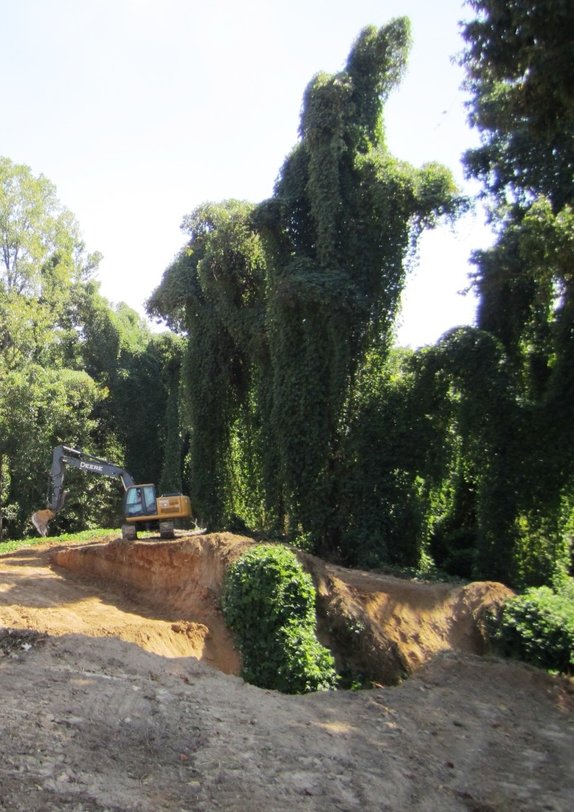
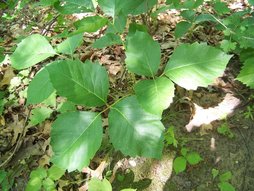
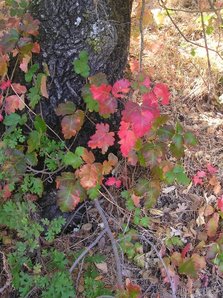
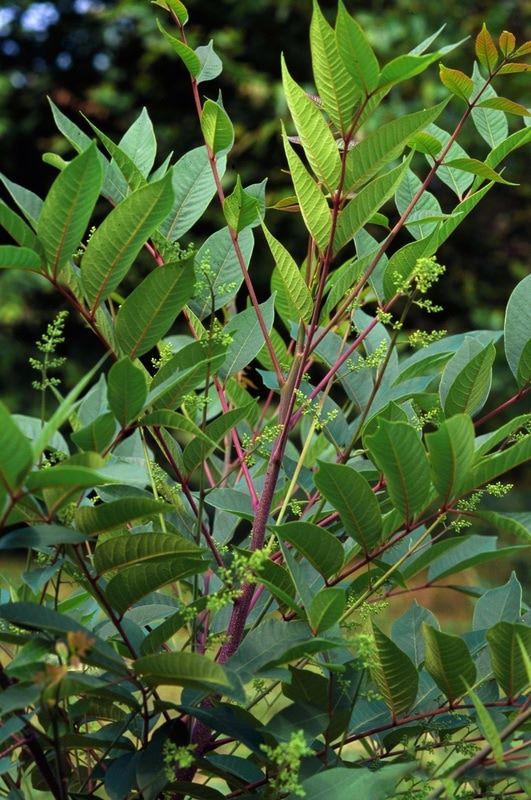
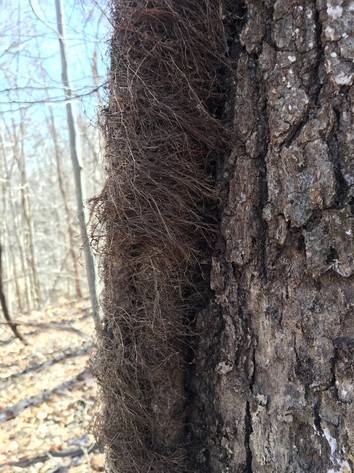
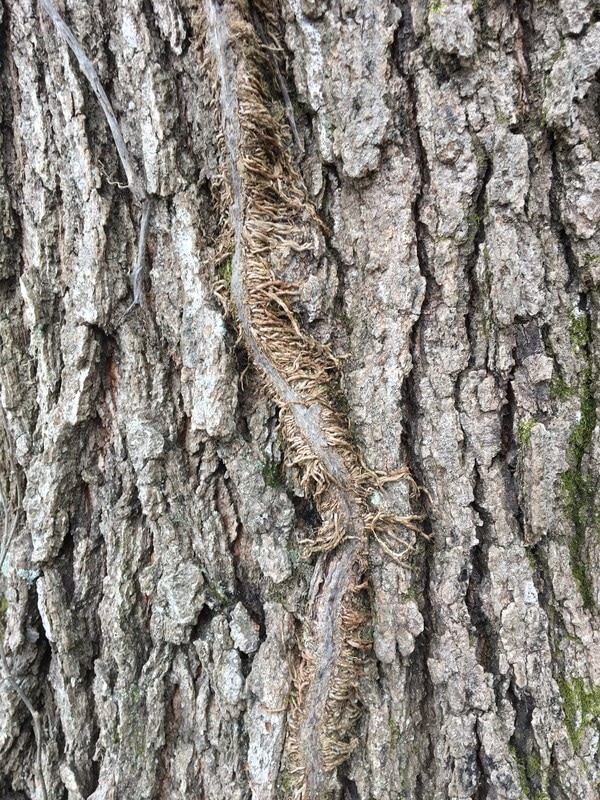
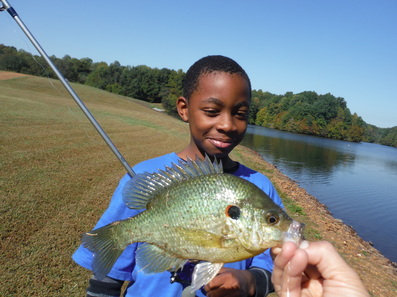
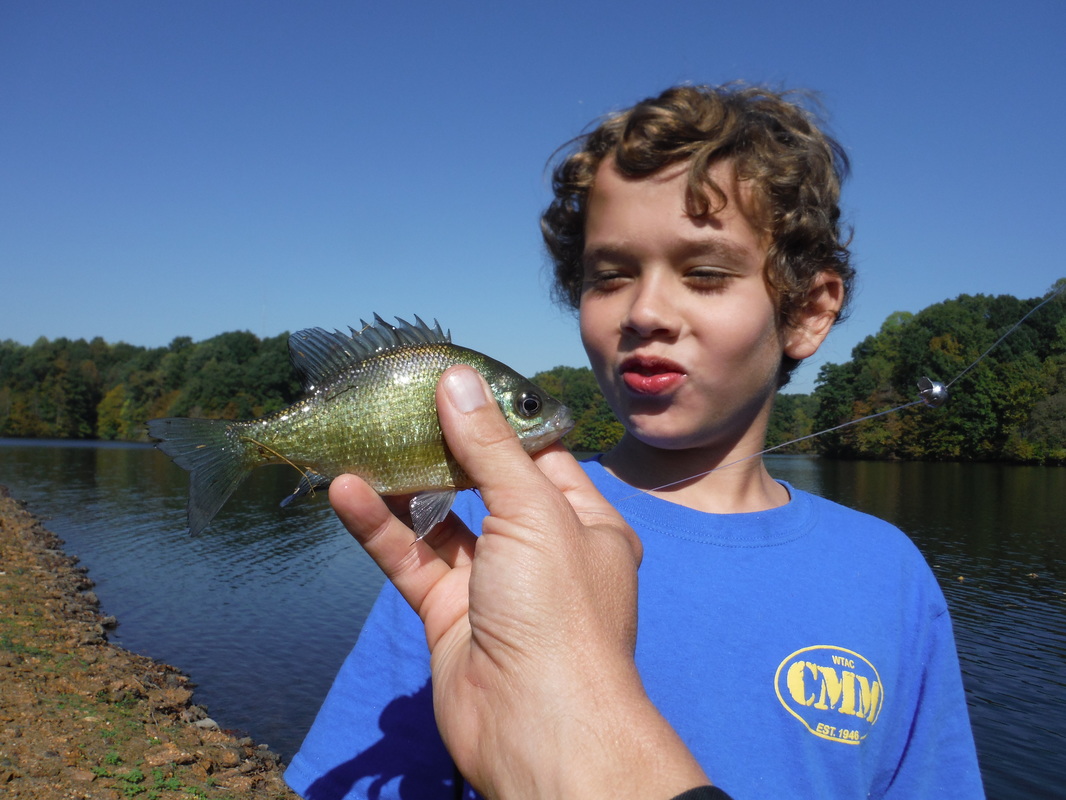
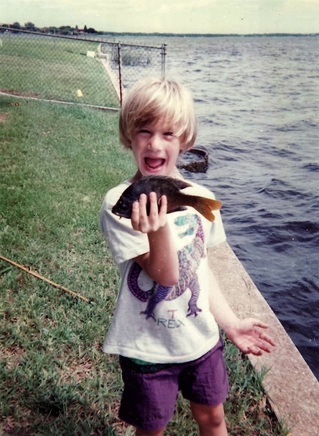
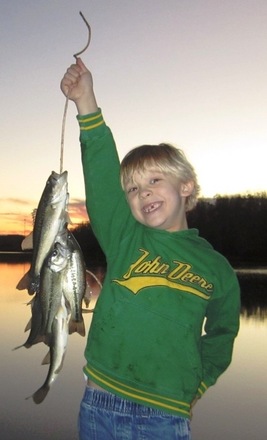

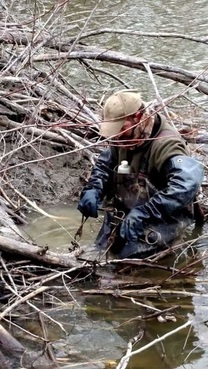
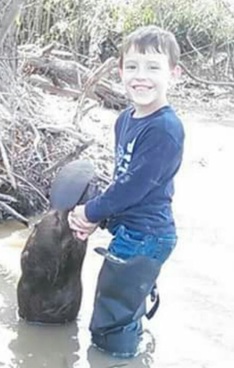
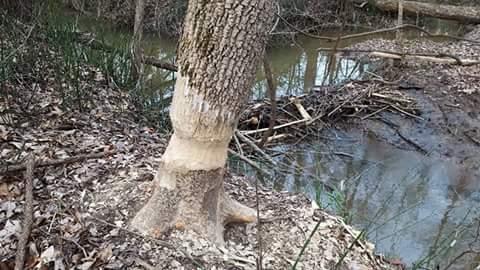
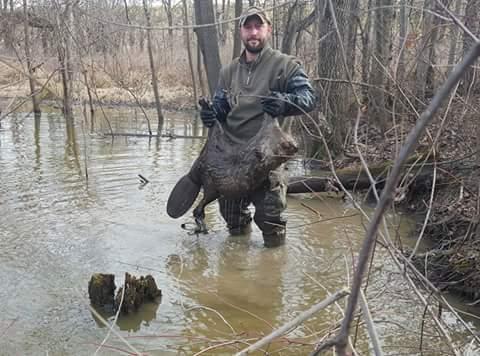
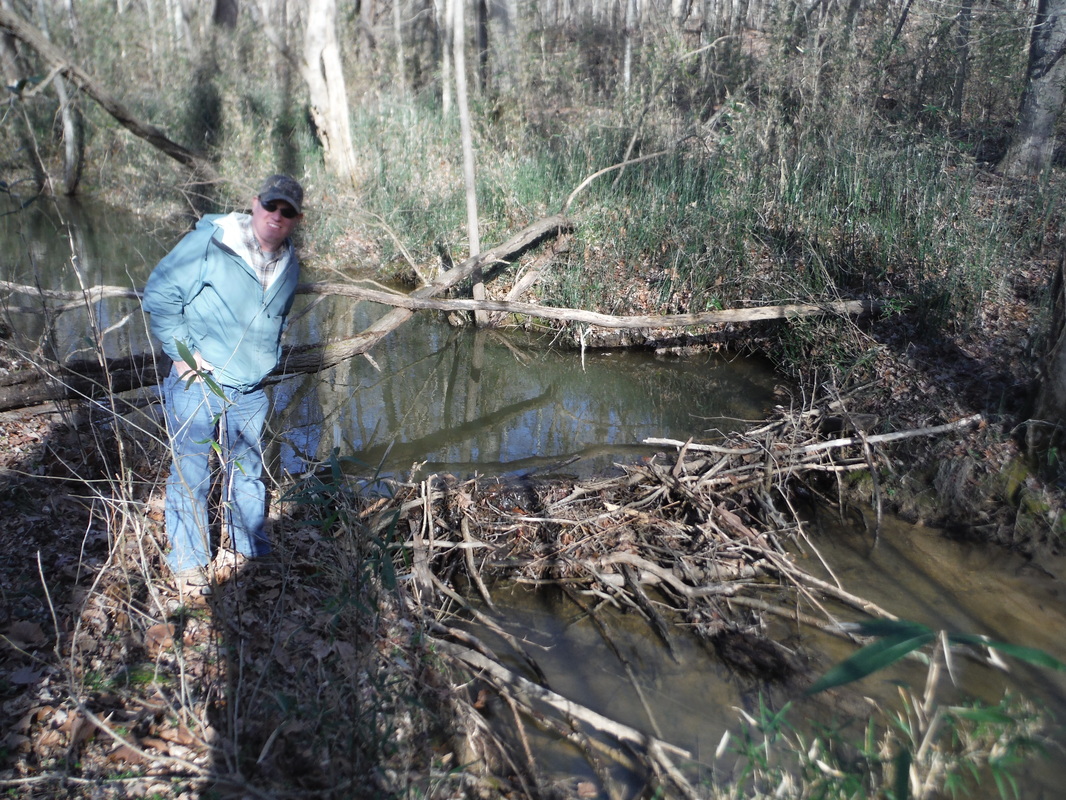
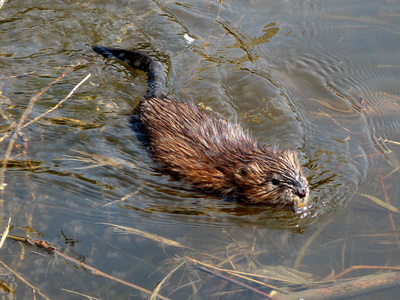
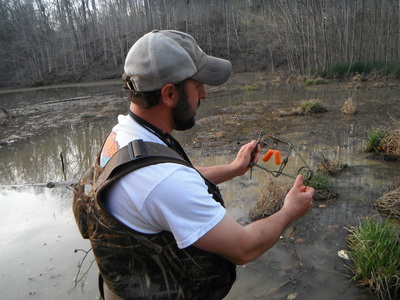
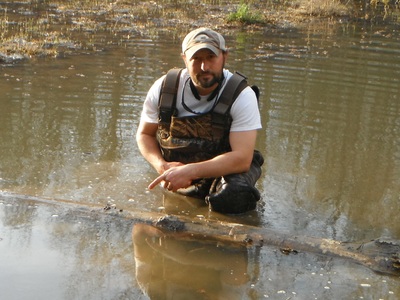
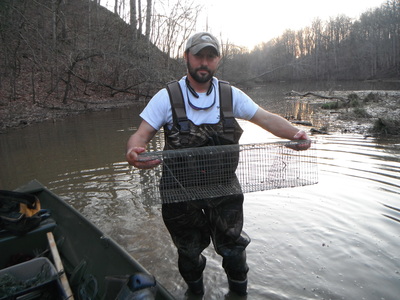
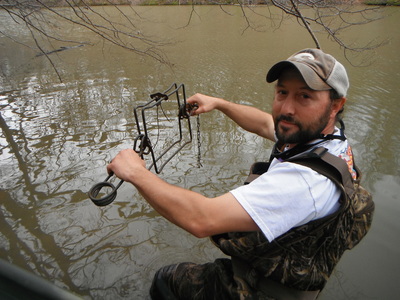
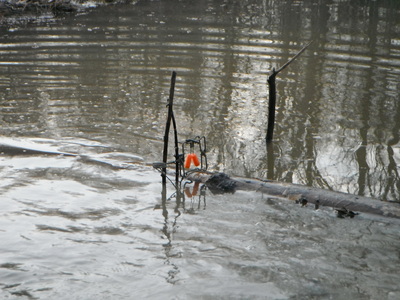
 RSS Feed
RSS Feed